HEALTH AND WELLBEING
Health efforts on campus and in the community

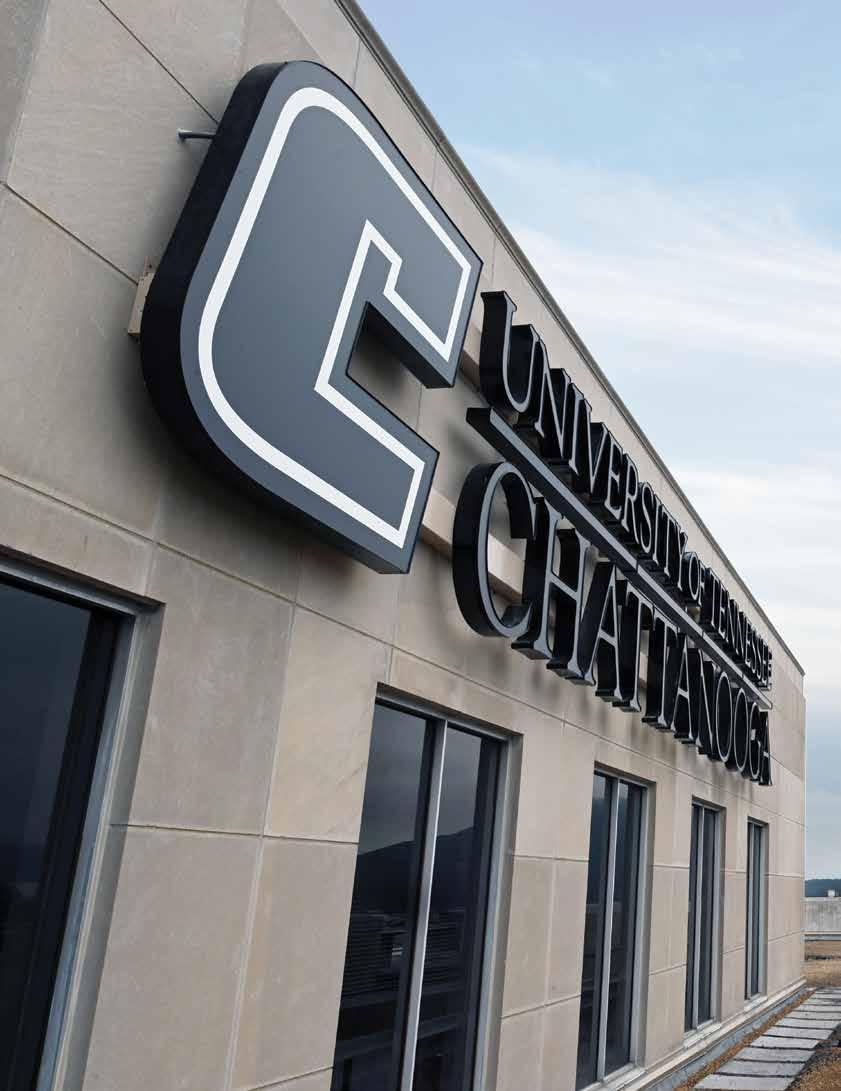
University of Tennessee at Chattanooga Magazine volume three, issue one | Fall 2019 utc.edu/magazine
EDITOR
George Heddleston
Vice Chancellor, Communications and Marketing
CREATIVE DIRECTOR
Stephen Rumbaugh
GRAPHIC DESIGNER
Lynn Newton
WRITERS
Sarah Joyner
Shawn Ryan
Megan Shadrick
Gina Stafford
Chuck Wasserstrom
CONTRIBUTING WRITER
Farron Kilburn
PHOTOGRAPHER
Angela Foster
VIDEOGRAPHY
Mike Andrews
Jacob Cagle
WEB
Chris Gilligan
We welcome your feedback: magazine@utc.edu
A new UTC sign on top of 540 McCallie overlooks Chattanooga and Lookout Mountain as seen in daylight— the sign is also internally illuminated for viewing at night. On the cover: Future doctors of physical therapy celebrate their transition from the study of pre-clinical to the application of clinical health sciences at the 2019 “White Coat Ceremony” in Patten Chapel.

4 Message from the Chancellor 6 Building a Program, Leaving a Legacy 9 FUSE Tackles Demoralizing Cycle 10 Impacted by the Power of Higher Education 12 Degree of Difficulty: Andrea Fuchs Overcomes and Achieves 14 Assistance for Rural Health Disparities 15 MPH: One Year Later 16 UTC Grad is Athletic Trainer for the Circus 19 Memory Minders 20 Coin Art 22 Historic Patten Chapel 24 Lending a Hand 26 Fighting Leukemia at Nanoscale 28 Dealing with Rural Community Drug Abuse 30 Rooms for Relaxation 32 Medical Humanities 33 Closing the Health Care Gap 34 Cost-Saving Kiosks for Children’s Hospital 35 Bookshelf 36 Athletics 40 Alum Notes 42 Notabilis
The University of Tennessee at Chattanooga is a comprehensive, community-engaged campus of the University of Tennessee System. The University of Tennessee at Chattanooga is an equal employment opportunity/affirmative action/Title VI/Title IX/Section 504/ADA/ADEA institution.
MESSAGE FROM THE CHANCELLOR
Welcome to the Fall issue of the University of Tennessee at Chattanooga Magazine. This is a milestone year for UTC as we mark the 50th anniversary of our transition from the University of Chattanooga to being part of the University of Tennessee System.
In 1969, the University of Chattanooga, a private liberal arts school, transitioned to a public institution, the University of Tennessee at Chattanooga, charged by its board with “effecting continued movement toward academic excellence.” The merger also included an agreement with the United Methodist Church and Chattanooga City College, formerly Zion College, located six blocks from our campus, and signaled a broadening of our public education mission.
As we reflect on these 50 years, words penned by UTC’s first chancellor, Dr. William H. Masterson, in the 1969 Moccasin yearbook captured the roots of UC and the promise for growth in the years ahead. His words resonate today and indeed still define the direction for the University of Tennessee at Chattanooga:
“Nothing in campus life lies outside a student’s university education. Musical productions, dances, dramatics, student publications, athletics, fraternities and sororities, special interest groups, concerts, “bull sessions” in the dormitories and student government are all as much a part of a college education as classroom and laboratory.
“In all these areas, as well as in the broadening of the curriculum, the education at Chattanooga will be strengthened by the change before us. We shall be larger, but not unmanageably or impersonally so. Our tradition of concern for teaching and student welfare will still be very much a part of us.
“On the other hand, the enlargement of the student body and the faculty will provide the numbers and diversity of interests that will give all these curricular and co-curricular activities the necessary vitality to become valuable to more university men and women. Similarly, our campus will become a larger, more coherent physical entity that will provide proper facilities for these activities.
“These things will not come overnight and the new face and personality of the University will evolve over the years, just as new traditions will be added to but not supplant our present ones. The point is that no “new” university wholly strange and different is to replace the present one. Rather the University that we know will, we believe, develop greater breadth and more opportunities for those of you with whose lives it will always be associated.”
This issue of the magazine will highlight many of the people and accomplishments that are directly aligned with the vision articulated by Dr. Masterson. Happy reading!
Steven R. Angle Chancellor


BONUS CONTENT
Look for these icons to access bonus videos, photos and links to stories to learn more. VIDEO
4 | The University of Tennessee at Chattanooga Magazine
PHOTOS WEB
V I W
A cross colleges, across disciplines, all across campus, the UTC community makes a difference in health and wellness in Chattanooga and beyond. This issue of UTC Magazine brings you the work of an English professor to make doctors better at the practice of medicine. How the Physical Therapy program at UTC came to be the first in Tennessee to grant doctorates, now the professional standard. The chemical engineering research to make leukemia treatment more effective. Using data to make patient triage faster and more efficient. You also will get to know the new provost at UTC, Jerold Hale, and learn some interesting anecdotes involved in the history of Patten Chapel, celebrating a centennial on campus this year. And as always, we will catch you up on campus and athletics news and alumni notes.


6 | The University of Tennessee at Chattanooga Magazine HEALTH
BUILDING A PROGRAM, LEAVING A LEGACY
Career-Minded Ingram Juggles a Family Challenge and the Creation of a Doctoral Program
By Gina Stafford M ajor
milestones are coming for the University of Tennessee at Chattanooga’s highly acclaimed physical therapy program in 2020.

The program will mark the 30th anniversary of both its founding and its connection to longtime department head Debbie Ingram. The anniversary also will be the last in that role for Ingram, who plans to retire in May. Nancy Fell is succeeding Ingram, who began a yearlong transition as outgoing department head in May 2019.
It’s almost impossible to describe the impact and influence Ingram had in bringing the field of study to UTC and expanding the availability of physical therapy practitioners in Chattanooga and the region, but Valerie Rutledge, dean of the UTC College of Health, Education and Professional Studies, comes close.
“Dr. Debbie Ingram has been key to the success of the physical therapy program at UTC,” Rutledge says. “Her energy and enthusiasm for her students, her colleagues and her profession are evident in her positive attitude. She has been recognized at the state and national levels for her achievements and her contributions to physical therapy. Beyond her academic role, she has been a staunch and longtime supporter of all things UTC.”
A native of Cleveland, Tenn., Ingram earned a bachelor’s degree in physical therapy at Georgia State University in 1979, then joined the neurosurgical intensive care unit at Erlanger Medical Center in Chattanooga. By 1989, she was head of physical therapy and managing five programs for Erlanger. That’s when opportunity—and a former professor from Georgia State—came calling.
“Randy Walker and Grayson Walker both came to me in the fall of 1989. I was one of Randy’s students in 1979 at Georgia State, and Grayson Walker then was dean of the forerunner of the College of Health, Education and Professional Studies at UTC,” Ingram says. “They were starting a physical therapy program at UTC and they offered me the job of director of clinical education, but my husband and I had just adopted a baby girl. I had committed to—once we adopted the baby—staying home.”
Ingram learned something from that experience. “I discovered I was not a stay-at-home mom,” she says, and she took the job as UTC director of clinical education in 1990. Randy Walker, now a UTC professor emeritus and physical therapy adjunct faculty member, had been hired by Grayson Walker as developing director of the program-to-be. Grayson Walker, then dean of the College of Health, Education and Professional Studies, became >>
Fall 2019 | 7
UTC provost and the person for whom the Walker Center for Teaching and Learning is named. He died in 1996.
To build a brand-new physical therapy program, leadership wanted a practitioner engaged in the Tennessee Physical Therapy Association who knew therapists in the community and was familiar with all the hospital and clinic settings. That was Ingram.
Her job was to establish sites where students would complete clinical experiences. She and Randy Walker also worked furiously to write the curriculum and self-study coursework and hire faculty. When they weren’t doing that, they were recruiting and interviewing prospective students.
“We had to find good, qualified students who were willing to take a chance on our brand-new program,” Ingram says. “These developing programs are not accredited and won’t be accredited until the first class is ready to graduate, so you’re asking people to believe in what you’re doing and that they will end up having an accredited degree.”
Ingram had a master’s degree by the time she took the new job of UTC director of clinical education. She knew a doctorate would be required to achieve tenured faculty status. So, with a baby girl at home, creating a new degree program and preparing to teach at a university for the first time, Ingram also became a doctoral student at UT Knoxville before online education existed.
“It was stressful, but Randy Walker gave me some great advice. He said choose a topic, a theme for your research and stay on course with that theme,” Ingram says. “Our daughter began losing her hearing at age 3 and I was in a law class at UT Knoxville when that happened. My professor in that class suggested I stay on that topic, do something in regard to implementation of the 1990 Americans with Disabilities Act and its impact on colleges and universities; particularly because I worked in the rehabilitation profession—the tie to the ADA and to people suffering disabilities and challenges to people with disabilities and the lack of accommodation.
“When our daughter lost her hearing in 1992, it made what the ADA was about real and even more relevant to me. My doctoral dissertation dealt with the Americans with Disabilities
Debbie Ingram helps as her daughter, Alex, tries on Debbie’s doctoral regalia. When Alex graduates from UT Knoxville in December with a Ph.D. in education, she will wear her mother’s cap and gown to the doctoral hooding ceremony.

Act and the admission of students into our program who might have disabilities.”
Ingram’s findings were published in the Journal of the American Physical Therapy Association, the field’s leading scholarly publication. That led to presenting at national meetings and following up with multiple related studies that also were published. She served on a national task force charged with identifying necessary changes for accommodation of physical therapists with disabilities.
She completed her doctorate in 1994, served on the Tennessee Governor’s Committee on Employment of People with Disabilities, then was appointed by Gov. Don Sundquist to the state physical therapy licensing board. In a few years, the field and the accreditation body agreed that a doctoral degree should be required to practice physical therapy.
“The profession determined that a DPT would be the entrylevel degree, and that’s when UTC brought in experts on the subject,” Ingram says. “We brought in one of the national vice presidents of the American Physical Therapy Association and sat down with the chancellor, provost and others as we moved forward with plans for the University’s first doctoral degree.
“I worked a lot with Chancellor (Bill) Stacy at the time. He championed this for us and it went before the UT Board of Trustees. UTC was first to then go before the Tennessee Higher Education Commission, and we had the first DPT program in the state of Tennessee as of 2000. It also was the first doctorate awarded—in 2003—by UTC in any field.”
Current practitioners can renew their licenses based on degree requirements at the time of initial licensure but, over time, a DPT will become the uniform credential.
Today, UTC students complete 36 weeks of clinical education within 300 sites that assure varied experience: outpatient settings, acute-care hospitals, rehab facilities, pediatrics, geriatrics, skilled nursing centers and home health. UTC grads have a 100 percent employment rate. The U.S. Bureau of Labor Statistics projects 34 percent growth in the field over the next five years.
Today’s UTC grads join 800 who preceded them at a program named Tennessee’s best for quality and value. UTC physical therapy grads will be among alumni such as Don Hamill and Harvey Hillyer, founders of Benchmark Physical Therapy with 350 sites in 15 states. “When you consider that the average physical therapist sees eight patients a day, and you think about the 800 UTC graduates out there, that’s a lot of lives impacted in a single day by the work of those UTC has prepared for the field,” Ingram says. C
V utc.edu/ingram
8 | The University of Tennessee at Chattanooga Magazine
FUSE TACKLES DEMORALIZING CYCLE
UTC professor, new graduates help the homeless
By Shawn Ryan B etween 2012 and
2015, John spent 1,315 days in jail at a cost of $114,405 to taxpayers. The 61-year-old was not a hardened criminal. He was homeless and mentally ill and, even when he was able to land decent housing, his psychiatric issues made it impossible for him to keep the dwellings.
The Frequent Users Systems Engagement project—or FUSE—hopes to break that cycle with a program that is now considering 50 homeless Chattanoogans who are most frequently in jail for drug arrests or in hospitals seeking help for psychiatric problems. This homeless group frequently is caught in a continuous spiral of arrest, jail, hospital, then back out on the street where the process is repeated.
UTC computer science students and faculty are helping the FUSE effort. Working with the Chattanooga Housing Authority, students have designed a website that patients can use to upload, among other details, consent forms for medical treatment and personal healthcare information.
The goal of FUSE is to provide housing for the participants “so the people do not have to walk the streets every day, often to the emergency room, and then they are discharged back to the street,” says Li Yang, Guerry professor in the UTC College of Engineering and Computer Science and former faculty advisor on the FUSE project. (Yang is currently on leave in Washington, D.C., serving as a program director for STEM research sponsored by the National Science Foundation. Once her two years at NSF are completed, she will return to UTC.)
Help from UTC was critical because, under the federal Health Insurance Portability and Accountability Act (HIPAA), medical information is private and accessible only by the patient and healthcare professionals authorized by the patient to see it. When designing the study’s website, UTC students were able to create computer firewalls to protect the information from anyone not authorized. “We wouldn’t have been able to get this far in the project without the students’ help and expertise,” says Tyler Yount, director of special projects for Chattanooga Mayor Andy Berke’s office, which in 2018 created the Chattanooga Interagency Council on Homelessness to address the issue citywide.
Figures from a three-year study by the mayor’s office show that 5,243 local inmates are dealing with a mental health issue. Out of the group, 75 percent also showed up at local emergency
rooms. The cost of these inmates to the city, Hamilton County and local hospitals was $2.7 million over three years, according to the study. “I thought (assisting) was a really good project, and I think it'll do really good for a lot of people, so I said ‘Yes,’” explains Jacob Monroe, who graduated from UTC in May with a bachelor’s degree in computer science and began work toward a master’s degree.
“It feels great to be part of a big project that's communitybased and also being able to apply my cybersecurity knowledge to give back to the community,” says Hector Suarez, a graduate student in computer science also working with the FUSE project. “It makes me feel that I was able to contribute just a little bit for the greater cause.”

Yang says she became interested in the project after law enforcement representatives from Chattanooga and Hamilton County gave a presentation at UTC about FUSE. “I found it very meaningful and important for our community, so I decided to work with them and support the data-driven discovery part,” she says.
“The first step is to identify needs, which means how many frequent users we have in our community who will require supported housing. And then the second step is trying to identify them and then outreach them and provide help,” she continues.
According to Psychiatric News, those with mental illness stay in jail almost twice as long as those charged with identical crimes. Even when they’re released, those with psychiatric problems have no place to live and find it difficult to get community-based medical help. Thus, the in-jail or in-hospital cycle continues.
Helping the helpless is a primary reason Monroe got involved with FUSE. “I think the people who are homeless need help and they don't have the means,” he says. “I feel like this will actually get them on their feet and (able to) contribute to society in a meaningful way.” C
W cfgc.org/hcsofuse | V utc.edu/fuse
Fall 2019 | 9 COMMUNITY
Hector Suarez
IMPACTED BY THE POWER OF HIGHER EDUCATION
New Provost Hale Brings Life’s Lessons to UTC
By Gina Stafford
F amily, Integrity, Belief in the transformative power of education. These aren’t simply important to Jerry Hale. He says they make him who he is.
Hale became provost and senior vice chancellor for academic affairs at the University of Tennessee at Chattanooga in July—the latest in a career of noteworthy appointments—but he says professional accomplishments “really wouldn't mean much to me if I didn't have my family as a support system and an entertainment system. My family really brings me more satisfaction than anything else that I do.”
His accomplishments include serving as dean of arts and sciences at the College of Charleston following a similar post at the University of Michigan-Dearborn. Hale also has served as head of the speech communication department at the University of Georgia and held faculty appointments there, at Miami University of Ohio and the University of Hawaii.
He has a bachelor’s degree in political science from the University of California-Los Angeles and master’s and doctoral degrees in communication from Michigan State University.
Ask what led him to pursue his field of study or to the posts he’s held
in academia, and he says “serendipity.” The best kind of serendipity, he adds, because it showed him the power of caring, engaged teachers and mentors. “My whole adult life has been almost one serendipitous encounter after another,” Hale says. “I went from high school (in central California) to college because one high school teacher told me that I ought to. I went from UCLA to graduate school because one professor told me that I should. I went to Michigan State for graduate school because I met the right professor.”
First Generation
As a first-generation college student, he was a little overwhelmed at first, and it showed in his grades. “I started as an English major, and here's a fun fact: I was on academic probation after my first quarter there,” Hale says. “Luckily, shortly after that, I met a very young and new political science professor who was teaching a class in political leadership. He saw potential in me that I think a lot of other people didn't see. He helped me get back on the right track, academically, and I was always interested in politics, so if it weren't for that professor, my life might've gone in a different direction.”
Upon earning a bachelor’s degree at UCLA, Hale headed to Arizona State
University for graduate school and to serve as a debate coach. Once there, a faculty member fresh from earning a doctorate at Michigan State gave Hale advice that radically altered his career plans—again. “He told me that he thought there were better things in store for me than living out of a suitcase, going to debate tournaments for the rest of my life, so that's how I ended up at Michigan State,” Hale says, noting the national prominence of Michigan State for its communication arts and sciences program. “Again, a serendipitous meeting of a particular faculty member who influenced my life in important ways.”
Aloha
Hale’s first teaching post after earning a doctorate was at the University of Hawaii, which he praises for the quality of its students, faculty and research. Living in paradise wasn’t cheap, though, and on a starting salary just below $20,000 (in the 1980s), it soon became unfeasible. He returned to the continental U.S. to join the faculty of Miami University in Ohio.
Athens, Ga. became his next home when he joined the speech communication faculty at UGA, including serving as department head.
10 | The University of Tennessee at Chattanooga Magazine
PROVOST
He says his three children all grew up in Athens, which is still home to a daughter and granddaughter. One son and grandson live in Austin, Texas; his other son and grandson live in Charlotte, N.C.
The opportunity to become a dean at the University of Michigan-Dearborn took him back to the state where he and his wife first met in graduate school and where she grew up and still has family. “Athens is very much your quintessential college community, and Dearborn is anything but—it’s very urban, a metropolitan university,” Hale says. “The Michigan-Dearborn provost, chancellor and faculty all had forward-thinking vision about making an important impact on Southeast Michigan, and what they did there they were just marvelous at doing.”
Varied Educational Experience
For instance, he says, Ishmael Ahmed, a colleague at Dearborn and cabinet member for former Michigan Gov. Jennifer Granholm, led university outreach and community service to immigrant populations. “That became a set of functions that later grew into a major medical center,” Hale says. His ever-broadening higher education experience—from large land-grant to engaged, urban metropolitan university— served Hale well as he became dean of arts, sciences and letters at the College of Charleston. Results of a campus climate survey made public just as he took the job in 2013 revealed some opportunities for improvement in diversity. “I wanted to get out in front of those kinds of issues, and we did some diversity training both for staff members in my school and for the department heads,” Hale says.
He brought in an industrial-organizational psychologist and former UGA colleague with workforce diversity expertise. The result was a training and development model to enhance staffing and hiring pool diversity that impressed the provost so
much, it was replicated across the campus. That provost was George Hynd.
Years later, Hynd—who hired Hale at Charleston—was interim UTC provost when Hale ran into him at a professional conference. Hynd wanted to hire him again. “He said, ‘Look, you really need to do some research about UTC. They're going to be doing a provost search, and you'd be a good candidate,’” Hale says. “I thought about it for a while and started diving into the website and anything else that I could find. What really attracted me is it’s another metropolitan university. After being in Dearborn and then in Charleston, which is a metropolitan university, I felt much more comfortable with a metropolitan university that was also a regional comprehensive university than I might have felt 15 years earlier when I was still at the University of Georgia.”
He was drawn to UTC’s priority on experiential learning, student success, growing research productivity and commitment to equity and diversity. He joined UTC July 1 and, ever since students returned to campus in August, he’s been working on getting to know them. “I don't know a lot about the students yet, but I'm hoping to get to know them better,” he says. “What I do already know is that there are a lot of students here that remind me of me when I was a student. I was a first-generation college graduate, and I've always been drawn to first-generation students or students who, in other ways, might've been at-risk.
“I think we're about 25 percent first-generation students, so we have an opportunity to do something that's really transformational for them. It's one of the things that attracted me to (UTC), because I really believe the work that faculty members do here has the opportunity to impact students.” C V utc.edu/jerry-hale

Fall 2019 | 11
"...there are a lot of students here that remind me of me when I was a student. I was a first-generation college graduate..."
In addition to serving as UTC provost, Jerry Hale is a photographer and avid outdoorsman.
DEGREE OF DIFFICULTY
Andrea Fuchs Overcomes and Achieves
By Megan Shadrick
C hallenges and unexpected situations occur for most college freshmen, but Andrea Fuchs faced something uniquely difficult.
As a high school graduate from suburban St. Louis, Fuchs was excited to be leaving her hometown and on her way to study journalism at the University of Missouri. But the month before moving into her residence hall, she started having debilitating health issues.
Fuchs was diagnosed with and still has an autoimmune disease that weakens her whole body. Walking became difficult because Fuchs didn’t have the strength to stand. Seizure-like episodes started ramping up in severity and included dizziness, headaches, loss of muscle strength and double vision. The disease made it difficult for Andrea to move her legs; she was easily fatigued. Eventually, she wound up partially paralyzed and in a wheelchair during her freshman year at Mizzou.
A Former Athlete
In high school, Fuchs was a multi-sport athlete, competing in volleyball, soccer and gymnastics, but the disease progressed to where she was unable to do any of the competition that she loved and missed. “I had to learn very quickly a drastic change in life. I was an athlete and had to change to a wheelchair,” says Fuchs, who eventually made her way to UTC and earned a master’s degree in social work in 2019.
The UTC connection came when Fuchs met future husband Brett while in Missouri. They met online and their connection grew quickly. Only a few weeks into their relationship, Fuchs was in her wheelchair full-time. Brett says the physical struggles were not a hindrance to their relationship, and it actually helped them connect. “We fell in love very quickly,” Brett says.
The couple moved to Chattanooga in 2016 when he was hired as associate dean of students at UTC. Andrea Fuchs enrolled at UTC and, despite her disabilities, completed her master’s.

Andrea’s long list of diagnoses includes fibromyalgia, degenerative disc disease, chronic pain, compromised immune system, heat intolerance, neuropathy and PTSD. The combination of these issues and the medications to control the symptoms exhaust her daily.
She fought through those difficulties and spent three years managing her health while taking courses full-time in Missouri. She tried different types of classes, including online courses, night classes or courses with other options, but it was difficult.
12 | The University of Tennessee at Chattanooga Magazine
ADVERSITY
In May 2018, Andrea Fuchs earned a master’s in social work with service dog Zorro by her side.
Ultimately, she had to cut down her class load for her undergraduate education. The constant issues, fainting episodes and lack of mobility took their toll.
Bad to Worse
During this time, she was in her wheelchair part-time, but one day became fully paralyzed after picking up a simple item. “I was just lifting something in my wheelchair and twisted my back… I went from needing my wheelchair most of the time because I could still walk some to being fully paralyzed,” she says.
But she still managed to earn a bachelor’s degree in social work.
After moving to Chattanooga, her first year consisted of visiting Siskin Hospital for Physical Rehabilitation four to five times a week for one to two hours each day for therapy. The effort and hard work eventually helped get her out of the wheelchair and walk with minimal assistance. Learning to walk again was “incredibly weird,” she says. “It’s kind of frustrating. Because you’re like, ‘This was so simple when I knew how to walk the first time.’ This didn’t feel like so much work and brainpower for ‘How do I move this foot?’”
After about a year, Fuchs met her service dog Zorro, whom she started training when he was 10 months old. He has been her constant companion for five years. The 80-pound black Labrador retriever is cute, but he’s much more than that. He’s a huge piece of Fuchs’ independence. She says he’s part of the family and Brett lovingly calls him “Son.”
Zorro helps Fuchs get out of chairs and, once she’s up, he helps her stay upright because she cannot feel her feet. One of his most critical abilities
is sensing when she’s about to have an episode. He starts licking her hand and continues to lick until she acknowledges him so he’ll know she understands what he’s telling her. How dogs can sense seizures is not totally understood, but one theory is a person’s scent changes just prior to having one.
Once she had Zorro at her side and was more mobile, Fuchs began studying toward her graduate degree at UTC. There were certainly struggles along the way, but teachers and administrators helped her by making sure study materials were online and by giving her extensions for assignments at times. She also has
her time in the graduate social work program, one in the Disability Resource Center, which she says “was really a great avenue for me to learn what resources we had on campus and what things needed to be improved.” She also worked as an intern at the Helen Ross McNabb Center. Today, she serves as a supportive living team leader at the center.
“My internship helped others realize that, instead of my disability being a barrier or hindrance, it was really a strength of what I brought to my internship, employment and mental health treatment,” Fuchs explains. The McNabb Center also allows her to work a flexible schedule and have Zorro with her at work. “My 40-hour, full-time job is set up on a six-day schedule which allows me to work at varying times,” she says.
equipment that recorded the lectures. “That meant listening to the four-hour lecture all over again,” she says.
Pushing Through
Her struggles have been fairly constant throughout, forcing her to fight for everything she has. She regularly deals with insurance companies, healthcare providers and college, all while holding a full-time job at Helen Ross McNabb Center, which offers outpatient mental health services. These activities bring their own share of problems, but Fuchs has learned to communicate her needs and also learned her legal rights. “I can’t expect for it to be done right unless I tell someone exactly what I need,” she says.
She worked two internships during
The flexibility is crucial because she still has days when her health issues overwhelm her. Sometimes she’s knocked down by little things that most of us take for granted. For example, she avoids taking showers in the morning because she’s just too worn out after them. “I can’t expect myself to do as much as before my illness or to the level of my peers,” she says.
Despite the obstacles, she maintained a 4.0 GPA in her master’s program, something she was unable to do with her undergraduate degree. She says her accomplishments at UTC showed that “I could do what everyone else could do; I just needed it adapted.” It has also taught her a lot about herself. “It’s kind of shown me that I could push myself a little further than I thought, but also taught me how important taking care of myself is.” C
Fall 2019 | 13
“I could do what everyone else could do; I just needed it adapted.”
ASSISTANCE FOR RURAL HEALTH DISPARITIES
Master’s Degree in Public Health Students Involved at RAM Clinics
 By Shawn Ryan
By Shawn Ryan
TThe 23-year-old was a single mother living in Rhea County. She had one child of her own and was raising two others. Neither of the two children were hers, and the fathers were not in the picture.
All the children were five years old or younger but, unable to find or pay for childcare, she took them with her to a Remote Area Medical (RAM) clinic to get a free general medical exam and perhaps have several teeth pulled. “She had a vibrant personality with a positive outlook and nothing but gratitude for my volunteering and for the services RAM provided,” says Zach Farley, who was working at the RAM clinic and registered the woman for treatment, one of 50 or so people he helped at the clinic over two days, some of whom waited overnight to make sure they got in. About 500 people came through the clinic on those days, Farley says, seeking free medical, dental and vision care.
A New Understanding
“I was humbled by the experience,” says Farley, a UTC student in the master of public health (MPH) program. “It is amazing how simple it is to take things for granted, me coming from a middle-class household in Middle Tennessee with two parents with college degrees. I simply was unaware of life outside that bubble. Though many of the RAM participants were underserved, underrepresented and not paid attention to, most were happy, had positive outlooks on life and were grateful for the opportunity to have healthcare at RAM.
When we think about health care for the homeless or poor or disadvantaged, our minds often turn to city sidewalks, says Mark Stoutenberg, head of the MPH program and associate professor of health and human performance. Those are the people we see regularly, the ones often discussed by city councils and social organizations, he says.
But what about the folks who live in rural communities; the ones who can’t afford healthcare either, but need it as badly as anyone? Don’t they deserve attention, too?
“Many times we think first to our urban or inner-city populations, but our
rural populations suffer from equal or even greater health disparities,” says Stoutenberg. “We needed to provide exposure to all of the different settings to students.”
That’s where the RAM clinics come into play. A program that began in early 2018 takes students in the MPH program at UTC to the clinics’ locations, which are spread throughout East Tennessee, and gives students a chance to encounter situations they may face in their careers. “From Day One, we strove to find ways to educate our students and provide them realworld exposure to different communities experiencing health inequities,” Stoutenberg says.
Different Assignments
On a first-come, first-served basis, the clinics are free for patients. Some have veterinary services. Over a weekend in March, nine UTC students worked at a RAM clinic in Cleveland, Tenn., staffing the registration desk, giving them first-line experience in rural health care. “Some students chronicled patients’ social and demographic information, while others served as Spanish-language translators. A few guided patients to checkpoint stations, and a couple of students filled dental hygiene assistant roles. “All in all, it was a success that we plan to build upon,” Stoutenberg says.
The UTC students involved were able to intimately understand the rural communities being served. McKenzie
14 | The University of Tennessee at Chattanooga Magazine FAITH HEALTH
UTC students register patients at a recent Rural Area Medical Clinic.
Gregg grew up in Newport, a small town near the Smoky Mountains in East Tennessee, so she knows and understands the folks who live in rural communities. “People from rural areas are no different than those who are not,” she says. “They are some of the most kind and grateful people you will ever meet. At times, rural people are not as easily accepted in society, and many times they are mocked and discounted. People should not be defined by their upbringing or circumstances.”
More to Learn
UTC students are scheduled to participate in a RAM clinic in November in East Ridge, Tenn. Stoutenberg spoke to organizers of the event to find the best subjects that students could focus on. There were three:
» Information and education on physical activity and nutrition.
» More support connecting to resources as they left the clinic.
» Increase the reach of the clinic beyond the 1,200 people typically served.
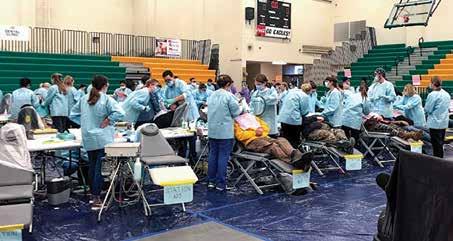
“The first need is right up our alley as a chronic disease prevention program. The second need is a fit for students majoring in social work, enabling them to learn expertise in directing clients to places where they can get more information,” Stoutenberg says.
“As well, approval has come for the involvement of physical activity/ nutrition educators and social work students,” he adds. “This will show the value provided rural patients, which addresses our third need—to increase the reach of the clinics.
“These RAM clinics have been around a long time and have a very deliberate set of procedures in place that have been refined over time,” he says. “We realize that this change will need to happen slowly, little by little.
His ultimate hope is to involve students across campus in the RAM clinics. “One of my long-term dreams is to fully involve the UTC community,” Stoutenberg says. “How can we get all of our health professional programs and students involved? There is certainly a role and a need for nursing, physical therapy, occupational therapy, social work and others to participate and really help our rural communities. My dream has UTC serving as a strong partner, engaging 100-plus students and really enhancing the care that our underserved communities receive.”
Although she grew up in a rural community, Gregg says helping others from similar areas gave her new perspectives and understanding. “I was reminded of how important it is to take the time to talk to people and actually listen to what they have or want to say,” she says. “I learned how important these clinics are and was shown how they positively impact lives in rural areas.” C
MPH: One Year Later

If Year One of the UTC master’s degree program in public health that launched in 2018 could be summed up in three words, they might be: cooperation, commitment and community. Cooperation by faculty from multiple departments and their administrators in taking on the graduate course load necessary to teach members of the initial, capacity, 20-student cohort; commitment of both faculty and students to maximize opportunities involved in bringing a new program to life; and community engagement in the form of partnerships enabling grad students to serve internships and conduct research within outreach organizations.
The diverse class—with a student composition of one-half from out-of-state, three international students and undergraduate degrees from nutrition to anthropology—embraced multiple opportunities to serve while learning. Students supported a twoday visit by Remote Area Medical clinics to give basic health services to underserved populations in Rhea County; hosted a series of informational programs during national Public Health Week; and completed Chronic Disease Self-Management Program Leader certification through a partnership with the Chattanooga-Hamilton County Health Department.
“There have been surprises, as you would expect, but the biggest is also one of the best— that the progress so far has met and exceeded all expectations,” says Marisa Colston, head of the Department of Health and Human Performance.
“Mark Stoutenberg (MPH program director) has done a very good job of pulling together a team of faculty, with support from me and the dean, and we’ve enjoyed great support going all the way up to the chancellor.” C
Fall 2019 | 15
Doctors, dentists, even veterinarians participate in the free clinics.
UTC GRAD JOINS THE CIRCUS
By Gina Stafford
W hat can you do with a master’s degree in athletic training from the University of Tennessee at Chattanooga? In the case of John Faltus, joining the circus is an option—Cirque du Soleil, that is.
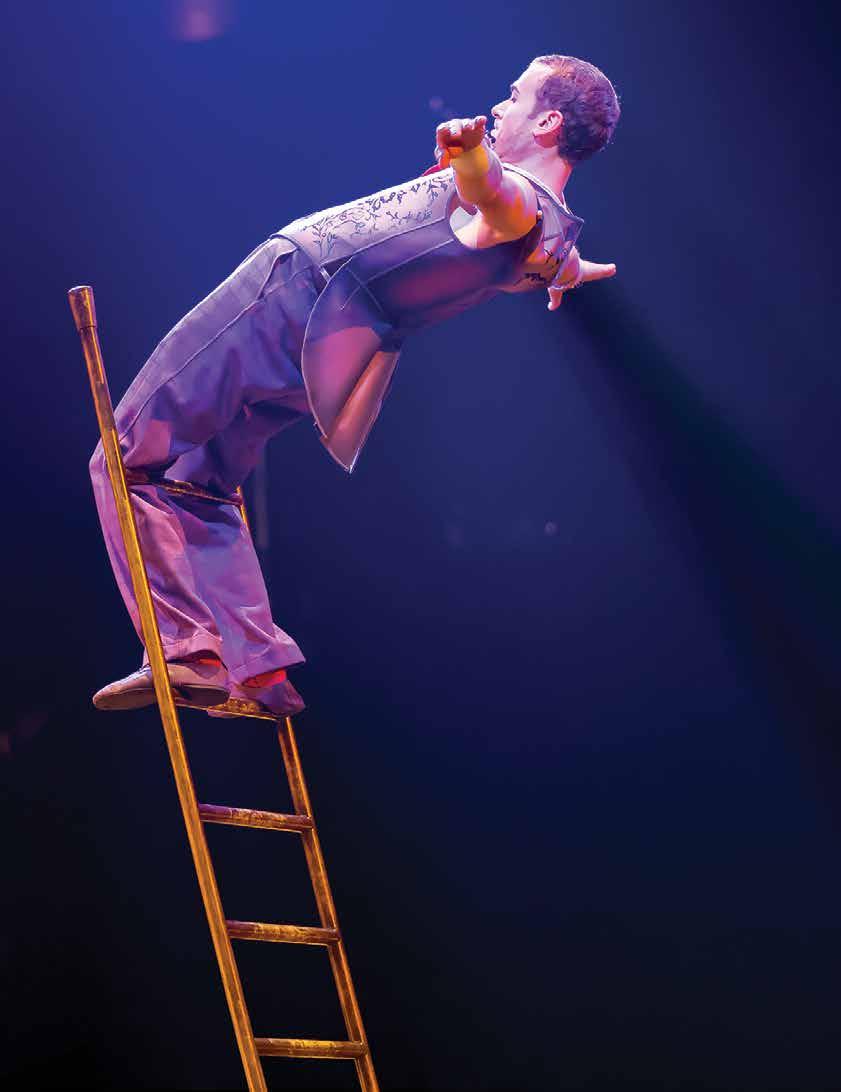
Faltus, a Rhode Island native who came to UTC by way of Boston, is today head athletic trainer on a North American tour of the Cirque du Soleil production Cortéo. Founded in the 1980s and today operating seven productions based in Las Vegas and multiple, simultaneous touring productions around the world, Cirque du Soleil is a Canadian entertainment company employing more than 5,000 acrobats, gymnasts, athletes and operations staff as the largest theatrical producer in the world.
“I definitely am a bit biased because I went through the program, but I would consider it one of the better graduate athletic training programs in the country,” Faltus says of UTC. “I had great mentorship through Gary Wilkerson and Marisa Colston during my two years at UTC. My only regret is I wish I’d had more time.”
After earning a bachelor’s degree in rehabilitation sciences in 2007 and a doctorate in physical therapy in 2008 at Northeastern University in Boston, Faltus came to UTC, where he completed a master’s degree in 2011. He followed that with a one-year Duke University fellowship in sports physical therapy. From there, he joined a Colorado-based sports medicine practice as an athletic trainer and physical therapist, then volunteered with the medical team at the U.S. Olympic Committee’s Sports Medicine Center in Colorado Springs in 2012 and 2014. A chance to work with the NBA brought him back to Tennessee, where he became an assistant athletic trainer for the Memphis Grizzlies
CHEPS
Cirque du Soleil is latest stop in John Faltus’ successful career
professional basketball team in 2014. “The opportunity to work in the NBA was something I had always been motivated to pursue,” Faltus says, “and during my years at UTC, I actually had the opportunity to intern with (NBA) medical staff, both at summer league and training camps, and get experience that way. That enabled me to get my foot in the door in a way and get the necessary kind of exposure to the world of professional sports, which is very different from even college or a clinic setting.
“And even prior to that, I had the opportunity to work almost two years in Vail, Colo., and travel a bit with U.S. Snowboarding. I've had a diverse background and skill set that has led me on this kind of career path that has somehow placed me in a very unique opportunity now working with Cirque du Soleil and traveling the world.”
Named Head Trainer
Faltus joined Cirque du Soleil in August 2018 as head athletic trainer for a production of Kuríos, which was touring Japan, where Cirque has a large and enthusiastic following. “I don't know if I can truly put into words the experience in Japan,” he says. “Cirque has been going there for quite some time now, and it's really like the Beatles on tour. It's an amazing experience. The culture itself, the people there—they love, love Cirque.”
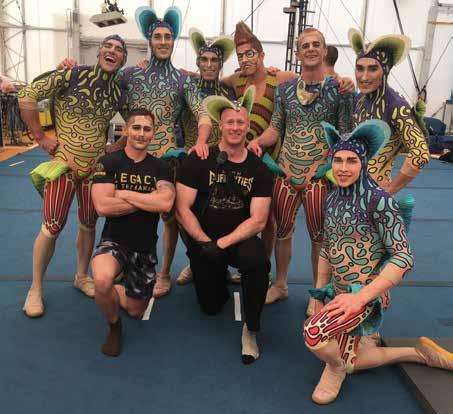
Faltus says his experience in Japan was enhanced by contacts through a former UTC classmate. “We graduated athletic training
school together, and he had a lot of local connections in Japan, so his setting me up with some of those connections before I even got there was tremendously helpful, and it allowed me to experience the culture and the food and that sort of thing in a very, very different way.”
Faltus also happened to have crossed career paths with an athletic trainer working for a Japanese professional basketball team. Reaching out to that friend led to stopping in to meet the strength and conditioning coach at the training facility of a Japanese professional baseball team. The visit happened on opening day of training camp with
a swarm of media there to see the baseball players, coaches, general manager and team owner. Faltus ended up meeting all of them, too.
“One thing led to another. The team manager wanted to see the Kuríos show,” Faltus says. After the performance, the baseball manager ended up in a question-and-answer session with local media. “Next thing I know, I'm in newspaper headlines and photos with the manager of that baseball team after he went to Kuríos, smiling and shaking hands.”
And what about the actual work, tending to performers in artistic, acrobatic and highly athletic Cirque du Soleil shows? >>
Fall 2019 | 17
"As a clinician, it really challenges you to create programs that best prepare them for those demands."
John Faltus, circled above.
“Their arena, their playing surface, is hanging upside down from a bike or being tossed from one platform to the other across stage and bouncing 15 feet up into the air off a net. I mean, it's just so many different skill sets that they have. As a clinician, it really challenges you to create programs that best prepare them for those demands,” Faltus says.

UTC Opened Doors
He’s been on tour with the production traveling North America since May. “When we were in Japan, we had a little bit bigger staff because we had more shows per week and a bigger artist group to accommodate those show demands,” he says. “Since joining (this) arena tour, it's myself and another therapist, as well as local doctors and massage therapists that we will bring in to provide service for the artists as needed on a weekly basis.
“Because we travel so much, so often, you don't necessarily have the one network you go to because you're in so many different cities, not just in the U.S., but all over the world. You really rely on your local medical network, and the networks that have been previously established from other shows that have come through.”
Leading with praise for Health and Human Performance department head Colston and Wilkerson, a member of graduate athletic training faculty, Faltus says UTC helped open doors to a rewarding career doing work that he loves. “In
terms of the research application within the field, I had great experience there through research projects on campus as well as presenting at national conferences and the opportunity to network through the National Athletic Trainers’ Association,” he says. “And because of the connections to UTC and all the great work that Gary and Marisa have done over the years to not only build the program, but on a national level to get the students more involved and recognized in terms of their academic pursuits and career endeavors.”
Colston recalls Faltus as exceptionally engaged and involved, traits she credits for his career success. “One of the main attractions when we recruit students to the graduate athletic training program is the existence of so many opportunities for experiential learning and networking beyond the curriculum. Yet the very thing that attracts students becomes burdensome to many of them once in the program,” Colston says. “John was not like that. I remember him always asking to be engaged in initiatives and projects that Dr. Wilkerson and I had going. When students do that, they excel and get far more from the program and its faculty. That is what John Faltus did as a graduate student, and he continues to do as a health care provider.”
“UTC definitely left a great impression on me,” Faltus says, “and has allowed me to pay it forward, so to speak, in the years thereafter.” C
18 | The University of Tennessee at Chattanooga Magazine
MEMORY MINDERS
Jill Shelton Provides Meaningful Engagement Strategies for Older Adults
By Chuck Wasserstrom
C onsider this scenario: Your spouse asked you to pick up an item at the grocery store on your way home from work, and the supermarket was indeed on your route home. Once you noticed the store’s sign, your brain reminds you of the task at hand. “Oh yeah, I have to remember to pick up that spice at the store.”
For most people, seeing the grocery sign is the trigger to stop at the store; it’s a spontaneous retrieval process. But when it comes to older adults, they’re not always able to experience that spontaneous retrieval process. Even vivid cues around them aren’t good reminders.
Exploring the cognitive processes of how the brain changes across a lifespan is the driving force behind much of the research performed by Jill Shelton, an assistant professor of psychology at UTC. Her work has focused on cognitive aging and behaviors in which outcomes can be transformed.
“This has been a lifelong endeavor for me, and it’s a topic that I’m very passionate about,” says Shelton, who received
her bachelor’s and master’s degrees from UTC (and a Ph.D. from Louisiana State University). “I am genuinely intrigued by older adults. I love their stories. I appreciate what they have to contribute.”
While a certain amount of cognitive decline is a normal part of aging, “we know over time that there are real changes in the brain,” says Shelton, who studies both healthy aging and dementia. “But you may have to just adjust your perspective. Getting a diagnosis like dementia doesn’t mean that this is the end of the road for you. It just means that the road may take you in a different direction.”
Shelton spoke with excitement about a research project she supervised for a student’s master’s thesis last spring at Summit View Senior Community, an assisted living facility in Chattanooga. The facility has a diverse group of elders in terms of health status; some are independent, some are in assisted living, some have neurological disorders. “We went through a five-week intervention where we taught them everyday memory strategies,” she says. “We taught them things they could do to remember their new neighbor’s name or ways to remember to call their granddaughter on their birthdays. Maybe they wanted to remember a clip from a TV show to tell their friend.
“We saw benefits to their confidence in their memory. We saw fairly high levels of mastery of those strategies.”
Shelton says they focused each week on a memory strategy that had been empirically demonstrated. For example, they trained older adults to be strategic about how they set up reminders; if you must remember to take medicine when you go to breakfast, put the medicine right by your breakfast food— and not on a sticky note reminder left by your bed.
“Another week, we taught them about a strategy that helps you remember people’s names by associating a face with a name,” she explains. “It’s called ‘encoding’ in the cognitive psychology world, where you’re basically getting information into your memory system.”
Shelton is passionate about teaching older adults these tips and strategies so they will have a tool kit to improve their cognition. “As people get older, and we’re going to be on this Earth for that much longer, we want to be enjoying ourselves, maintaining quality of life, and doing all the things that we’ve always done,” she says. “We may have to change the way we do things a little bit, but we should be able to continue living our lives the way we want to live them, regardless of how we age.
“I’m getting older every day, too. I think as I age, I’ll continue to become increasingly invested in this work.” C

HEALTH
Photo by Rene Böhmer on Unsplash
COIN ART
Alumnus is a Renowned Numismatist
By Shawn Ryan
The three-ring binder is as thick as a Bible with both Old and New Testaments.
In it is the life of Chester “Marty” Martin, who graduated from the University of Chattanooga in 1962, toting a diploma for a degree in art. Inside the binder are handwritten letters from, among many others, artists Andrew Wyeth and Norman Rockwell and the directors of the Smithsonian Institution and the British Museum in London, which have Martin’s coins in their world-famous collections.
Martin plans to donate the binder and its historical papers, letters and photos to UTC in the future.
“This just pretty much chronicles my professional life,” says Martin, 85, who lives with his wife, Pat, in the same Chattanooga house they’ve lived in for 54 years, moving in two years after they were married.
As he flips through the pages in his binder, his memory is sharper than an engraving tool, and he easily recalls names and places, where this dinner was held, when and where he met this person.
Skilled Artist
It’s been quite a life for Martin, who is a painter in both oils and watercolors, a sculptor, a woodcarver and, in perhaps his most notable career, a numismatist or, for those who don’t recognize the word, someone who uses plaster or porcelain to engrave the original artwork that is later minted as coins.
“I had to teach myself how to make a coin; there is not a book that you can find that says how to make a coin. So I had a lot of learning to do,” Martin says.
But he learned fast. When he submitted a photo of his first coin engraving to the Franklin Mint in 1966, he received a letter from Joseph M. Segel, founder of the mint, which sells coins, medals, jewelry and other items. “It appears from the picture you sent that you may have the talent necessary to become a fine coin and medal designer,” Segel wrote.
He was right.
Martin worked at the U.S. Mint in Philadelphia from 1986 until 1992 and, in those years, he engraved or helped design coins for subjects such as commemorating the efforts of singer/songwriter Harry Chapin to end worldwide hunger, the works of artist Wyeth as part of the 100th anniversary celebration Yosemite National Park, the bicentennial anniversary of the U.S. Congress and the reverse side of the White House Bicentennial silver dollar in 1992.
Life of Art
Martin began pursuing art as a student at Brainerd Junior High in the mid-1940s when teachers noticed his artistic abilities. Under recommendations from Brainerd’s teachers, he enrolled at Kirkman Vocational High School in 1952 and after graduating enrolled at the University of Chattanooga.
For a few semesters, he studied with UC art instructors George Cress and Gail Hammond before joining the U.S. Air Force. When his enlistment was up, he returned to Chattanooga to finish his degree.
Art has dominated Martin’s life ever since. He began his full-time career designing billboards and posters and, from there moved to renderings for a host of local architects, including Don Wamp, father of Zach Wamp, former U.S. Representative for Tennessee's Third Congressional District.
His career in coin engraving began in 1980, but its roots go back decades to when he was a kid reading comic books. “On the back, comic books always had offers of some kind. Contests and things you could write for or send a quarter for and get an amazing amount of material.”
He carried the habit of checking out the back of magazines into adulthood and that’s where his coin engraving began.
In 1980, on the back of The National Sculpture Review magazine, he saw an ad for the Society of Medalists’ 50th anniversary contest. Winning prize was $10,000. Although he’d never worked in metal before, he decided to enter and created a three-inch, circular medal with a snail engraved into it. With a spiral shell, it sits on a spiral-twisted vine and gazes at a spiral galaxy in the sky.
It won the contest.
The late George Cress, former head of the UTC Department of Fine Arts, wrote a personal note after Martin gave him a copy of the medal in the early 1980s.
“I want to express my appreciation to you for your prizewinning medal for the Society of Medalists,” Cress wrote. “I have this on my desk and am pleased to be reminded of your outstanding achievements as one of our graduates."
More Achievements
A 36-inch, bronze replica of the coin now hangs in Brookgreen Gardens, a wildlife preserve and sculpture garden in South Carolina. Director of the gardens Joseph V. Noble later commissioned Martin to design a membership medal for
20 | The University of Tennessee at Chattanooga Magazine
ALUMNUS
Numismatist: someone who uses plaster or porcelain to engrave the original artwork that is later minted as coins
Chester "Marty" Martin has designed dozens of coins over the past 40 years.
Brookgreen. It features a raccoon on one side and palmetto palms on the other, both indigenous to South Carolina. Martin’s resume after that is jam-packed with notable moments.
After sending a “fan mail” to Andrew Wyeth, he received a handwritten note from the artist, saying, “It is a great pleasure to me to hear you say that my paintings mean something to you.”
In 1964, after Norman Rockwell’s painting “The Problem We All Live With” was published in Look magazine and caused a furor because it showed a little black schoolgirl walking among whites instead of being subservient, Martin sent a letter supporting the artist and the bravery of his work. He received a letter back.
“Dear Mr. Martin, I cannot tell you how much I thank you for writing your kind letter. It was so very thoughtful of you. Sincerely, (signed) Norman Rockwell." The original letter now is in the Rockwell Archives in Stockbridge, Mass.
First Time Request
In the years since, he has received correspondence from, among others, the executive director of the National Numismatic Collections at the Smithsonian, the Keeper of Coins and Medals at the British Museum and executive director of the American Numismatic Association.
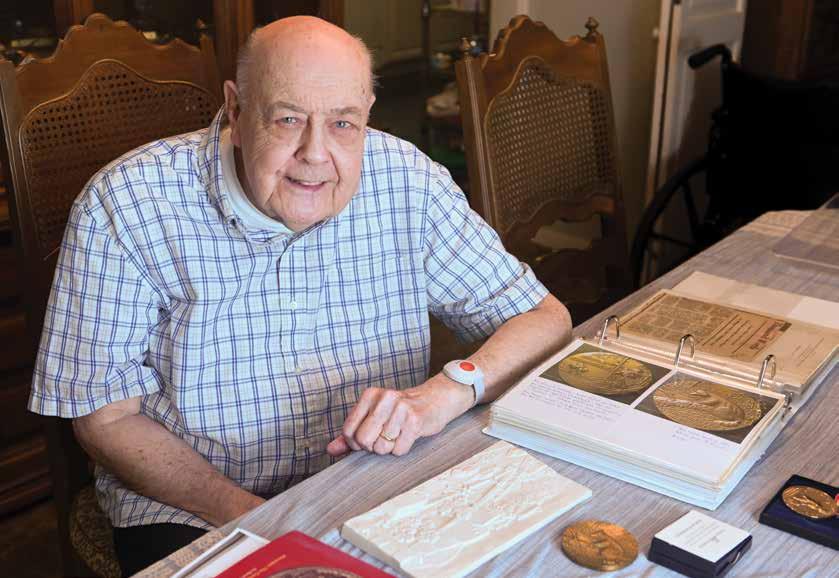
In 1984, the American Medallic Sculpture Association was asked to supply a medal for the World Food Day contest, the first time such a request had been made of U.S. artists. Martin entered the competition and won.
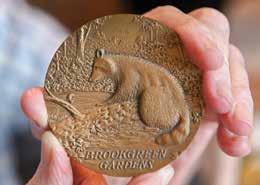
In 1988, he was hired by the U.S. Mint. One of his personal favorites is the Congressional Gold medal to honor four-star Gen. Colin Powell, commander of American forces in operations Desert Storm and Desert Shield and former chairman of the Joint Chiefs of Staff. It was the last project Martin did at the Mint.
“And boy, we worked,” Martin says, pointing to the four stars on Powell’s shoulders depicted on the coin. “He had to be able to see all those stars; all of them had to show on both shoulders.”
The coin’s face had Powell’s portrait and the reverse showed him talking to a foot soldier.
“It's supposed to show some humanity,” Martin says.
When Martin returned to Chattanooga after his time at the U.S. Mint, he was asked to use his talents locally. One request was to create a porcelain images for the 50th anniversary of McKee Baking Co., home of Little Debbie snack cakes. The artworks feature incredibly detailed portraits of company founder O.D. McKee and his wife, Ruth.
“I got a lot of good comments on that,” Martin says. C
Fall 2019 | 21
This Patten Chapel marriage register lists the names of couples married in the Chapel from 1919 to 1943. The marriage of Edith Isabel Patten, the daughter of the chapel's namesake, and James Abshire was the first wedding ceremony held in the chapel.
A booklet containing hymns and prayers for Patten Chapel services. Methodist chapel services were a routine part of university life until 1969.
This document shows specifications for Patten Chapel. instrument was made by Henry Sons, a prominent organ building based in Louisville,

Patten Chapel
Every college campus has iconic buildings, but only one campus has Patten Chapel. The building in the heart of the University of Tennessee at Chattanooga campus also is the only chapel on a public college campus in the state of Tennessee, and 2019 brings Patten Chapel’s 100th anniversary at UTC.
A memorial gift of $75,000 in 1917 from Edith Manker Patten to honor her late husband funded construction of the John A. Patten Chapel. Patten and her children gave the chapel to the university—then known as the University of Chattanooga and affiliated with the Methodist Church—and the building was formally dedicated at ceremonies on May 30, 1919.
It soon became the place for the most significant ceremonial events in students’ collegiate careers—honor society and Greek organization inductions, white coat ceremonies for health sciences majors, SGA Outstanding Senior Awards presentations—and has hosted countless musical performances, concerts, documentary filming and video interview sessions.
CHAPEL OF LOVE
Constance “Connie” Ford Blunt knew she would be married in Patten Chapel from the first time she stepped inside it in 1964. She was a freshman and went to “chapel,” a then-required weekly religious service for students. “I was in awe of the architecture, the greatness, the character and the total ambience of this holy place,” she says. “I looked around and said, ‘Oh, my goodness. I love this place. This is my Westminster Abbey. I want to get married here someday.’ ”
Three years later, she did.
Connie Blunt and Terry Blunt first met at Chattanooga High School, but their age difference and his entry into the military kept them from being in college together. When Terry Blunt came home to Chattanooga on a break from military duty in January 1967, they began dating. A week later, he went to Texas for training. Over his weeklong return to Chattanooga in March, they got engaged. Then he was sent to Germany and didn’t return until December. They were married on Dec. 23, 1967 in the chapel. “This aisle, when you’re 21 years old, is a very long walk,” Connie says. “It was just a really special evening and a special wedding.”
Laura Ward and David Ward met at a pool party when both were in elementary school. The next time they met, both were UTC freshmen. At a party following orientation, they talked. By Halloween, they were dating. “I walked in and thought, ‘Oh, the aisle was so much shorter before,” she says of her wedding. “It felt like it was a million miles long. It was packed, so it seemed like a lot of people. It’s a gorgeous place. It’s beautiful.”
They were married on July 14, 1990.
Laura Robbins was an undergraduate physical therapy major when Matt Robbins showed up as a graduate teaching assistant in class one day. He used
her as his mock patient in the class. Soon she was his real girlfriend and, later, his fiancé. Before their wedding, Patten Chapel was the scene of another important event: the “white coat ceremony” for Laura Robbins and her classmates. The ceremony marks students’ transition from preclinical study to applied clinical health sciences. “When she had her white coat ceremony here at Patten Chapel, I surprised her and took off work early so I could be here for that,” Matt Robbins says. “It was really special.”
Laura Robbins had heard wedding ceremonies had to be booked two years in advance, so when she called and learned of two open March dates just months away, she reserved St. Patrick’s Day 2018. “I was so nervous, but also so excited,” she says of her wedding day. “We’d put so much planning into it and we’d been dating four years.”
“I like the idea that the chapel is still there,” Matt Robbins adds, “that they’ve not removed it from campus or deconstructed it to be rebuilt somewhere else. It’s a part of history. It’s a beautiful chapel. I’m glad that it still stands and students are able to come and not only view it, but use it and have it be a part of their lives.”

THE HEART OF CAMPUS
Patten Chapel is among the oldest buildings on campus, along with Founders Hall and Race-Hooper Hall. “And at the time of its construction, it was among the largest buildings of its type in the city,” says UTC Executive Vice Chancellor Richard Brown. “Until mega-churches began to build, it was one of the largest assembly facilities of a religious nature in the whole county.”
About 20 years ago, a capital campaign helped fund a major renovation, and Brown says people still go to Patten Chapel for solace in tough times. “Particularly when the terrorist attacks of Sept. 11, 2001 happened, that space became a refuge for the campus community,” Brown says. “It was ecumenical. Which religion did not matter, nor did denomination, ethnicity or nationality. People just sort of migrated there—it was the heart of campus in more ways than one—and I think that’s the kind of special place it holds in the hearts of those who are now or have been part of this campus.”
The Blue and Gold Memorial debuted at Patten Chapel in 2012 as a solemn service of remembrance of UTC faculty, staff, students and alumni who died in the past 12 months. It has since become a beloved annual tribute to deceased members of the UTC family and, in 2019, remembered more than 100 alumni, almost two dozen faculty, staff or retirees; and three students.
The UTC Office of University Events is responsible for scheduling and managing rental and usage of Patten Chapel, the adjacent Danforth Chapel and Shakespeare Garden outside both facilities. Details on all three sites, rental fees and contacts to request a tour or make a reservation are online at utc.edu/chapel-info V
Fall 2019 | 23
utc.edu/chapel-of-love
the organ Chapel. The Henry Pilcher's building firm Kentucky.
Images courtesy of the University of Tennessee at Chattanooga Special Collections
An original blueprint for the nave trusswork of Patten Chapel drafted by Atlanta architect W.T. Downing. The beautiful wood moldings are a highlight of the Chapel's interior.
Why did you choose UTC?
I lived in Memphis and was ready for a change. I had heard great things about the school and city and wanted to try something new.
What is your most memorable experience at UTC?
Graduating with my undergrad in psychology.
LENDING A HAND
The UTC Department of Social Work Steps in to Help Firefighters
By Shawn Ryan
The 911 call comes into the fire department and the adrenaline starts to flow. Where’s the fire? How bad is it? How many firefighters does it require?
But it’s not a fire call after all. Some elderly or disabled person needs help getting up from a fall or from a wheelchair into bed. They may be having trouble picking up the TV remote, even getting something to eat.
“If you haven’t eaten in two days, getting a bowl of soup is an emergency,” says Capt. Skyler Phillips, Emergency Management Services coordinator for the city fire department. “Our main goal is to help people.”
Receiving these calls—known as “citizenassist” calls—is a problem stretching nationwide and, in some cases, slows firefighters responding to an actual fire or a life-and-death situation.
Chattanooga already has had about 1,600 such calls since the beginning of the year, according to Phillips. In January, one disabled man made 90 calls, he says.
The Department of Social Work at UTC is stepping in to help. In a pilot project that started fall semester, students in the master’s of social work program have spent several hours a week in the city Fire Training Center on Amnicola Highway. They gather information on who is making the calls, what the person’s need usually is and how many times they call over a period of time. From there, they will visit the person and help direct them to social-service organizations or churches or other groups that can help and, in turn, reduce the number of times they call 911.
“Hopefully, that’s where the student would come in and say, ‘OK, this is an individual that’s in need of some kind of community, maybe we need to connect them to a pre-existing organization
that has an adult-day program. Maybe there’s an organization that’s providing some kind of companion resource,’” says April Wilson, interim director of field education in the Department of Social Work and supervisor of the new program. “So instead of seeking out that support through the fire department, they now have an agency they can contact.”
Since the beginning of fall semester, UTC students Sydney Williams and Ciscily Crislip have been spending 16 hours a week working with the fire department on the citizen-assist calls. They say they’ve learned as much as the people who call the fire department for help.
“I’ve discovered a million resources that I didn’t even know existed in Chattanooga,” Williams says. “We thought we thought of everything, then we meet somebody else who has a need I never even thought about, so it’s ‘Oh, now we need to find another resource for this.’”
As part of the internship, they’ve been visiting some frequent callers in their homes once a week to assess their actual needs and try to find resources to help them, Crislip says. “Our main goal is identifying people who are frequent callers and are in need of something more than just someone coming and picking them up off the floor,” she says.
Cathy Scott, assistant professor and director of the bachelor’s in social work program, says the new program “is a natural fit for us.”
“Because social work assessment and evaluation and caring for the elderly is part of what we do,” she explains. “The message that I kept hearing in the meetings that I’ve been in is: Just reduce the common calls, but reduce them in a way that these individuals are still getting support.” C

24 | The University of Tennessee at Chattanooga Magazine
WELLNESS
From left, UTC social work instructor April Wilson, students Sydney Williams and Ciscily Crislip and Chattanooga Fire Capt. Skyler Phillips.
In a pilot project starting fall semester, students in the master’s of social work program will spend several hours a week in a city fire station.
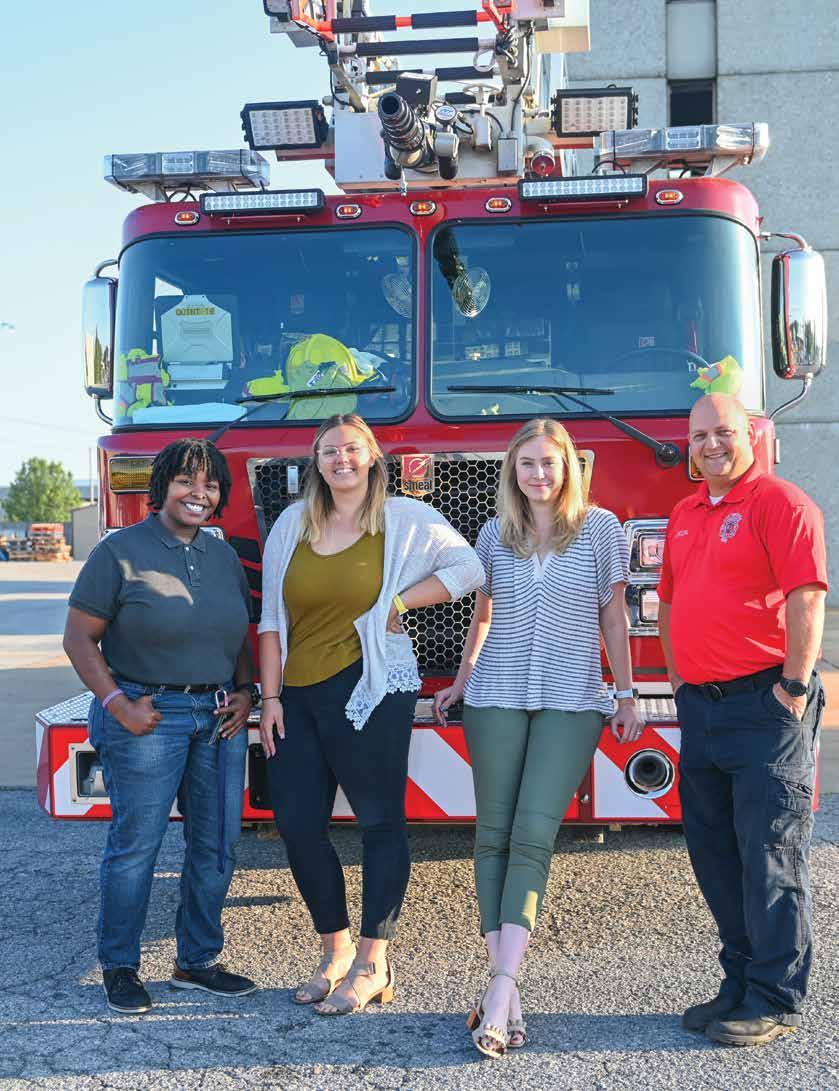
FIGHTING LEUKEMIA AT NANOSCALE
 By Gina Stafford
By Gina Stafford
26 | The University of Tennessee at Chattanooga Magazine
RESEARCH
M aximum effectiveness, minimal side effects, least-possible damage to healthy tissue. Scientists have long pursued cancer treatment offering one or more of these benefits, and a researcher at the University of Tennessee at Chattanooga is now among them.
Michael Danquah is researching a highly precise form of treatment delivery—at the nanoscale, molecular level—to fight leukemia.
Danquah researched vaccine production as a chemical engineering doctoral student and today is director of the chemical engineering program at UTC. He is working with pediatric oncologist Dr. Manoo Bhakta of Erlanger Health System to lead a team of researchers funded by the inaugural $25,000 award of the Collaborative Research Grant initiative, a partnership between UTC, the UT College of Medicine and Erlanger.
Receptors
They are investigating the use of aptamers—small RNA or DNA molecules that can bind to cellular targets and sometimes called the chemical equivalent of antibodies. Aptamers target “receptors” on the surface of cancer cells. In acute lymphoblastic leukemia (ALL) the type responsible for about 20 percent of all cancer in children and people younger than 20, a unique receptor is found, and Danquah is working on an aptamer to uniquely target that receptor.
“CD19 is a unique receptor, or biomarker, for B-cell acute lymphoblastic leukemia,” Danquah says. “So, after identifying such a unique receptor, the next stage is: Can you molecularly engineer a DNA aptamer? Can you design a DNA aptamer that can specifically target the CD19 on the tumor? It's all about understanding the features of the target receptor and how to develop or design that aptamer to recognize it.”
A successful aptamer design, in which the molecule binds to the targeted receptor, results in something called a “ligand,” a general term for a molecule that binds specifically to another molecule. “When you have a ligand that can target that specific receptor on the tumor, that'll be a significant breakthrough because you’ll have something that can actually identify a particular receptor on the tumor,” Danquah says.
Since receiving the $25,000 funding at the end of 2018. Danquah says great progress has already been made. The work has yielded two aptamer designs—one a DNA molecule, the other an RNA molecule—that can target the CD19 receptor. “The next stage is to synthesize these two aptamers and then test the binding mechanism,” Danquah says. “Once that is
done, we can incorporate the aptamer into drugs in a process called ‘molecular coupling’ or ‘conjugation.’ You couple the aptamers onto the drug so that the drug is delivered, the aptamer will navigate the drug to the receptor site.”
Collaborating Investigators
“The collaboration with Erlanger is fantastic,” Danquah says, “and using the UTC SimCenter we've managed to develop the initial models of the aptamer for CD19 that we will study. When we reach the phase of (laboratory studies) and then move to clinical phases, our collaboration with Erlanger will make that happen much more easily because clinical research is what they do.”
In anticipation of the years of work ahead for this project, Danquah will be working with two doctoral students with a similar research focus. “Both students started this fall, and once they're done with their courses, they will be actively involved, and I'm excited about that,” Danquah says. “The long-term strategy that I have for this project is to be able to build some form of Biomedical Center of Excellence that will be looking into developing new diagnostics and targeted treatment strategies for cancer and advanced pathogen detection systems. When I came to interview to join UTC last year, one of the things that excited me to come here was the opportunity to work with Erlanger.”
Recently, Danquah began collaborating with UTC’s Henry Spratt, a professor and microbiologist, and David Levine, a professor of physical therapy. Spratt and Levine are researching the presence of pathogens in healthcare treatment environments. These microscopic bacteria live on surfaces or may be airborne and cause infection in people exposed to them. With Danquah, Spratt and Levine are examining the possibility of incorporating aptamers in detection of those pathogens.
Meanwhile, Danquah is staying busy looking for funding sources for his research. He has a list of cancer research and prevention funders, including the National Science Foundation, National Institutes of Health and Prevent Cancer Foundation, that he plans to pursue aggressively to support his research. “Since I came here, I've been excited about the possibility of building the biomedical research capabilities of UTC so that we can become like a hub, whereby these hospitals and healthcare facilities around us can be collaborators and research partners with us to develop emerging biomedical technologies,” Danquah says. “That’s my long-term strategy.” C
Fall 2019 | 27
DEALING WITH RURAL COMMUNITY DRUG ABUSE
 By Shawn Ryan
By Shawn Ryan
T hey cried as they talked about their drug addictions, tears flowing as they waded through their guilt at the pain and turmoil they had caused their families and friends.
They cried as they confronted the waste they’d made of their lives and relived some of the horrific childhood neglect and physical abuse that contributed to their initial drug use. But when they were told they could stop talking, could stop dredging up the memories making them cry, they declined. “Our first priority was their well-being, so we would offer to stop
28 | The University of Tennessee at Chattanooga Magazine HEALTH
“Given the lack of access they have to appropriate services ... street drugs become a coping mechanism.”
their interview,” says Rick Dierenfeldt, assistant professor of criminal justice and a member of the University of Tennessee at Chattanooga Department of Social, Cultural and Justice Studies. “But each of them insisted on continuing. You really got the sense that it mattered to them that someone was just willing to listen to them.
“And there was a selflessness about so many of them, too. As we finished the surveys and thanked them for their time, I lost count of the number of people who thanked us for what we were doing and expressed hope that, even if they did not benefit from the study, that other people would.”
Great Support
In spring 2019, Dierenfeldt and three others in the Social, Cultural and Justice Studies department received a $50,000 grant from the Tennessee Department of Human Services to study drug abuse in rural communities. Working in tandem with the Southeast Tennessee Human Resource Agency, they traveled to three rural counties in Tennessee, where they interviewed 166 people convicted of drug crimes, hoping to get a better handle on the rural drug crisis.
“At this point, I think everyone is very aware of the fact that meth and heroin have swept through rural communities like wildfires,” Dierenfeldt says. “We see the deterioration within the community that comes with these kinds of drug markets—the loss of jobs and income, the closure of businesses, the increase in peripheral crimes and, really, the feeling that you are losing your community and the bonds within it.”
The opioid crisis in Tennessee is so acute that Randy Boyd, interim president of the University of Tennessee system, set up an Opioid Addiction and Response (SOAR) summit in early August to address the issue. Among the attendees were doctors, nurses, law enforcement officers, faith-based leaders, public health experts and addiction survivors. “I was blown away by the magnitude and depth of discussions that we had regarding this important issue,” Boyd wrote after the summit. “Society has harshly judged those who do suffer from addiction, but addiction is not a moral failure.”
While there can be a stereotypical view that people with drug addictions bring it on themselves because they’re too weak or lazy or lack self-control, the situation is far more complex than simple explanations can cover. “It’s easy to place blame entirely on the person and their choices, but at some point we must begin to recognize that all choices depend on
context. They don’t occur in a vacuum,” Dierenfeldt says. “Nearly all of our offenders have experienced at least one adverse experience during childhood and most experienced several, things like verbal, psychological and physical abuse while growing up in a household marked by domestic violence. Parental incarceration, drug and alcohol abuse and broken families are big contributors as well.”
Among those interviewed:
• 88 percent had used methamphetamine, 72 percent non-prescribed opioids, 39 percent heroin.
• More than half said that, when they were children, they saw their parents using drugs.
• More than one-third said they’d been physically abused.
• More than 20 percent had been sexually victimized as children, including half of the females.
• About 75 percent suffered from at least one diagnosable mental health problem.
They also discovered that nearly half of those interviewed had no access to a vehicle, making it almost impossible to look for work or, if they had a job, be able to get there on time. Lack of transportation makes it difficult to access any communitybased services such as substance abuse or mental health groups, job skills training or anger management counseling. “Given the lack of access they have to appropriate services, considered in tandem with the experiences many of them faced as children, street drugs become a coping mechanism,” Dierenfeldt says.
“The reality is that drugs are symptomatic of other problems in these communities and the lives of the people within them,” he says, so his study was “about identifying those problems.
“Like any other disease, you cannot effectively treat until you accurately diagnose.”
The ultimate goal, Dierenfeldt adds, is to understand which services are available to drug offenders in rural communities, from the services they actually used to the ones they thought would help but didn’t. “I’m not sure I would call it surprising, but it was certainly disheartening to find that rehabilitative services are generally lacking for these folks,” Dierenfeldt says. “Most have access to basic medical services and church services, but that’s it.” C
Fall 2019 | 29
ROOMS FOR RELAXATION
Seven Sensory Rooms Help Reduce Anxiety
By Shawn Ryan
The
room in Johnson
Obear
apartments was empty. Only bare walls and empty, carpeted floors.
And ceiling tiles. Routinely known as “popcorn tiles,” because their texture is bumpy and lumpy.
Students from the University of Tennessee at Chattanooga Mosaic program, which helps students with Autism spectrum disorders, looked around the room and had one complaint: the ceiling tiles. “We asked, ‘What would drive you to distraction in here?’ and they said those because they’re not flat,” says Michelle Rigler, executive director of Mosaic. So the tiles were replaced. But that was not the only change in what is known as a sensory room.
It now has low-level lighting, enough to see by but not a glaring, corporate-office feel. Paint has been completed in subdued colors. Weighted blankets feel all snuggly; beanbag chairs don’t make squeaky, annoying noises when you sit in them. There are squishy balls to squeeze, and lights that send soft, wavy shades of blue and green and other colors up the walls.
The whole idea is to give students—all students, not just those in Mosaic—the chance to decompress, to calm down. “Our sensory rooms are for anyone on campus, someone experiencing finals stress or high levels of anxiety. They serve various purposes,” says Amy Rutherford, associate director of Mosaic. “It’s a place for individuals to come in and decompress and really take a moment to pause and have a mindful experience.”

Studies have shown that the reduction in stress and anxiety provided by sensory rooms leads to less conflict among roommates and, generally, better behavior from students overall, she adds.
UTC is unique in its sensory rooms, Rigler
30 | The University of Tennessee at Chattanooga Magazine
WELLBEING
says. While other universities have only one such room on campus, UTC has seven. Currently, they are all in residence halls—Johnson Obear, Stophel, Stagmaier, UC Foundation, Decosimo, Guerry and Walker. Each is a little different than the others.
In the planning stages for the rooms, Rigler and Rutherford approached Abeer Mustafa, associate vice chancellor for student affairs and head of housing and residence life, seeing if she might be able to find empty rooms in the buildings. She jumped onboard immediately. “We loved the idea of providing students with space where they could find comfort and resources,” Mustafa says. “We hope that the sensory rooms will provide a calming space that can be utilized for self-regulation with a variety of items in the room so the student can calm down and get focused again and re-engage. The reality is that many students feel anxious and a sensory room can provide a sense of calm and a place to re-center.”
Among the major stress factors for students are homesickness, social anxiety, financial burden, maintaining academic success, sensory input and handling roommate conflict, Mustafa says.
If the students using the rooms show improvement in their stress and anxiety levels, the hope is that the rooms can be placed in other buildings such as the University Center, Rutherford says. “If there is a definite impact, we want to expand the sensory rooms outside the residence halls into other buildings.
“At UTC, we’re taking on a real focus on mindfulness and student wellness, so we want to partner with the Center for Wellness and the Counseling Center and even the School of Counseling and Occupational Therapy to open these spaces for lab use so they can come in and practice their techniques with people,” Rutherford says.
To that end, in the process of setting up the sensory rooms, they reached out to Ashley Mason, assistant professor of occupational therapy, who has studied methods for calming and reducing stress. “Often occupational therapists work with people who have sensory issues such as hyposensitivity or hypersensitivity,” Mason says. “We designed this room to create an environment that is more or less something that the individual can control to help feel calmer. I’m really excited to see how that’s going to turn out.”
Entry to the rooms will be through a university swipe card, which will serve another purpose beyond making sure the rooms are used only by UTC students, faculty and staff. “Each person who swipes a card to enter the room will receive a survey a few days later to provide feedback. We’ll look at what’s the impact over the course of a few months, a semester, and years,” Rutherford says. C V utc.edu/sensory-rooms
Sensory rooms use soft and colored lighting and other calming techniques to help students deal with stress.


Fall 2019 | 31
“At UTC, we’re taking on a real focus on mindfulness and student wellness..."
MEDICAL HUMANITIES
Literature Provides Pathways to Help Doctors with Patients
by Shawn Ryan
The assignment for the physicians was straightforward: Read fairy tales.

You read that right. Fairy tales. So what in the world does a physician get out of a fairy tale? “That’s what they said,” laughs Greg O’Dea, UC Foundation professor and associate dean of the Honors College who put the fairy tales in a syllabus he prepared for an annual physicians retreat.
But there was a method to what, while not technically peculiar, comes off as a bit odd. Each year for the past 15, O’Dea and Mark Anderson, an infectious disease physician at Memorial Hospital, have hosted a weekend retreat in which doctors and others read a preassigned list of books, poems, essays—yes, and sometimes fairy tales—then discuss them, tracing links between the themes they’ve read and how they apply to their jobs as physicians and how they do them. “When you have them read Grimm Brothers and stuff like ‘Little Red Riding Hood’ and ‘Cinderella,’ those seem to me to very much be maps of human consciousness,” O’Dea explains. “They’re sort of primordial; what 20th century psychiatrist Carl Jung would have called the ‘collective unconscious.’
“We can look at the patterns in fairy tales and see certain types of plot structures and certain types of themes emerging over and over again. That seems to me to have an awful lot to do with what one is doing when one is doing diagnostics: What are the patterns? What are the codes? I think I’ve seen this before; it looked a little different, but…,” says O’Dea.
The getaway conference has actually been taking place since the 1980s, when it was originally organized by Clif Cleaveland, a retired internist and UTC professor in the Honors College, and the late George Conner, the Guerry professor of English at UTC. “I graduated in 1964 from med school and the notion of medical humanities didn’t exist,” Cleaveland says. “But our patients had such complex backgrounds, we needed to understand them as people instead of just containers of disease.”
Over the years, the conferences have addressed such themes as “Apocalypse Now: Ethics at the End of the World,” “Food Matters,” “Wonderland: Classic Children’s Literature
and the Doctor-Patient Relationship” and “Vulnerable Populations.” Attendees have read works by writers such as Flannery O’Connor, Philip Roth, Salman Rushdie, Cormac McCarthy and Amy Tan.
Planning the conferences, picking the reading material and having discussions with the wide range of people who attend is inspiring. “They are incredibly insightful,” O’Dea says.
Anderson adds that seeing a patient as someone with a unique life story is key to giving them the best treatment possible. “To really take care of people as a doctor, you need to get their story; it’s all about getting their story. Knowing who they are, knowing their background.”
Take the current opioid crisis, Anderson says. Addicts are among the most difficult patients in health care, he says. “It’s very hard to take care of people who are addicted without having negative feelings about them. They exhibit unpleasant behavior that’s very difficult to deal with,” he says. “But we’re dealing with a disorder, a disease, even if they’re driving us to distraction with drug-seeking behavior or not being truthful with us. Knowing the patient’s background, what their life circumstances are and why they became addicted helps us to be better doctors. We really need to become adept at getting that story and understanding that story.”
The story continues until the very end, Cleaveland says, and becomes even more complicated. “They’re dealing with financial burdens, the cost of medical care. They deal with fear, doubt, identity. Those are not scientific issues, but they impact the future of a family or the future of a person.”
From a non-medical point of view, O’Dea says the annual conferences “really renew my enthusiasm, and it makes me think that what I do when I’m teaching has longer-term effects. It doesn’t just stop when they march across the commencement stage,” he says. “They’re going to carry that stuff forward. There’s a need for such training beyond one hour in the Ivory Tower.” C
32 | The University of Tennessee at Chattanooga Magazine PSYCHOLOGY
CLOSING THE HEALTH CARE GAP
UTC Leads Minority Health Fair
By Farron Kilburn A ttendance
at the 18th annual Hamilton County Minority Health Fair in August reached a record high, drawing more than 6,000 people.
In 2002, members of the Kappa Alpha Psi and Omega Psi Phi fraternities organized the first Minority Health Fair to address men’s health issues, especially men of color. Two years later, the Delta Sigma Theta sorority joined the effort, expanding the free event’s focus to also address health needs of women and children.
Participation by community residents and health care providers has grown each year, and vendors were at capacity in 2019 with 135 health care agencies, providers, schools and nonprofit organizations representing the health spectrum from ophthalmology and dentistry to insurance and hospice care.
Summer also brought the fifth anniversary of a partnership between the UTC School of Nursing and the Southeast Tennessee Health Consortium (SETHC), the nonprofit sponsor of the Minority Health Fair. The partnership launched in 2014 has resulted in more health screenings and education for fair participants—more than 1,000 to date— provided by the School of Nursing.
Federal grant funding awarded to UTC to combat obesity and reduce regional health disparities facilitated the partnership. More than 50 graduate nursing students and faculty work at seven stations, providing from 224 to 330 health screenings annually at the one-day event.
Screenings check body mass index, blood pressure, glucose levels, cholesterol (in those who meet screening requirements), balance and lung capacity for asthma. Consultations with participants ensure they understand their results and have resources for appropriate follow-up.
The event is an educational opportunity for UTC nursing students, too. Deb Palmer, a family nurse practitioner graduate student, describes the blood pressure screenings as eye-opening.

“While discussing the readings, I found that many clients I spoke to were uninsured, did not have a primary care provider or were unable to purchase medication due to cost. I was able to provide information about resources such as urgent-care facilities that provide primary care services at a reasonable cost, patient assistance programs for medications and medicines that may be free or purchased for low cost at some
pharmacies,” Palmer says.
“The patients were very appreciative of the information. The health fair gave me an opportunity to promote health in the community by educating patients and informing them of resources to overcome barriers in their health care.”
According to participating student surveys, more than 70 percent report having a “very good” or “excellent” experience, and more than 40 percent report learning something new that will inform their nursing practice.
Faculty and students with the UTC Department of Health and Human Performance also volunteer at the fair. For the past two years, public health students have helped coordinate participation by Spanish-language translators, organized lead-exposure screenings for children and provided event and vendor support.
Both the SETHC and Minority Health Fair are a result of seeking solutions to health gaps in Hamilton County. While racial and ethnic health disparities exist in the Southeast and are evident in every measure of health, Hamilton County African Americans have higher mortality rates in diabetes, heart disease, stroke and cancer than white residents. Since its inception, the Minority Health Fair’s motto has been: “Educate and empower minorities to close the gap.”
UTC School of Nursing Director Chris Smith praises the collaboration that has expanded the fair’s impact.
“We’re working together for the common goal of reducing health disparities for the people in our city and region,” she says. “It’s easy to be a good community partner when we’re collaborating with an organization that’s already doing such great work.”
Fall 2019 | 33 COMMUNITY
Shalane Lamb
C
V utc.edu/health-fair
Farron Kilburn is project manager for the UTC School of Nursing’s CANDL (Clinical-Academic Network for Developing Leaders) Grant.
COST-SAVINGS KIOSK FOR CHILDREN'S HOSPITAL
Student Project Streamlines Outpatient Registration
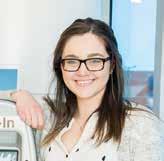 By Shawn Ryan
By Shawn Ryan
UTC?
I couldn’t stop talking about it after I toured campus. UTC was the only place I could see myself.
What is your most memorable experience at UTC?
My time as a Resident Assistant. I had so much fun getting to know my co-workers, residents and getting plugged into the happenings at UTC. I was an RA in Johnson Obear for two years. And I lived there freshman year as well, so I spent three years in JO. It has a sweet place in my heart. I met some of my best friends through the job and learned lessons I will never forget.
A nna Tenpenny admits she was “geeking.”
Walking through the brand-new Kennedy Outpatient Center for the Children’s Hospital at Erlanger, not only was she dazzled with the building itself, she also gazed with wonder upon the electronic kiosks that register patients at the center. It’s a system she and two other students pitched to Erlanger officials, suggesting they use it.
Erlanger did decide to use it, and the system is expected save the hospital about $1.05 million over five years. “I was thinking, ‘This is crazy! This is the project I was working on!’,” Tenpenny recalls.
In spring semester 2018, as a senior project in the Engineering Management Design course, she and partners Poet Jones and Tyler Pflug were tasked with crunching a mountain of data from Erlanger, comparing ways to streamline the registration process in the new outpatient center, scheduled to open the following December. The goal was shorter wait times for patients and also to save money.
“I was extremely overwhelmed in the beginning, especially since I had volunteered to analyze the data,” Jones says. “I didn't really know what I was getting myself into with over 7,000 data points.”
Using information from other Erlanger outpatient centers, they “were looking at how fast people went through the system, from when they checked in to when they were seen and when they left,” says Tenpenny,
who graduated in December with a bachelor’s degree in engineering management. At the end of the semester, the trio presented their advice to hospital officials: Use electronic kiosks instead of the less-efficient method of employees handling the time-consuming paperwork.
“We decided they needed three kiosks per floor in order to provide enough of them so that people could actually use them and there wasn’t a line, but also to make sure the hospital wasn’t spending an incredible amount of money beforehand,” Tenpenny says. Erlanger officials agreed and now there are three registration kiosks on each of the center’s three floors.
Tyler Shugarts, assistant administrator at Children’s Hospital at Erlanger, worked directly with the students who “were awesome” during the study. “They took such great initiative; they asked meaningful, right questions and were not afraid to admit when they needed some help. They really took the bull by the horns,” he says. “UTC as a school should be really proud.”
The students’ instructor, Wolday Abrha, assistant professor in engineering management and technology, says projects like this prove that students “are capable of solving real-world problems, not just a hypothetical classroom example.”
“At the end of the project, my expectation is students have developed the skill sets in managing projects, communication using written, oral and graphical methods, critical
34 | The University of Tennessee at Chattanooga Magazine
FAITH ENGINEERING
thinking at each stage of the project life and teamwork and interaction with multidisciplinary professionals,” Abrha says. Such skills are critical for success in future careers, he adds.
Both Jones and Tenpenny say they’re already using what they learned. “I use these skills now at my current employer by finding, analyzing and presenting data for process improvements,” says Jones, who works at Wacker Chemical Corp. as an electrical, instrumentation and controls technician and deputy supervisor. He plans to graduate in May from UTC with a degree in engineering management.
Tenpenny landed a part-time job in Erlanger’s Process Improvement department doing essentially the same thing she did in the outpatient project. Using data from the hospital, she helps develop ways to make operations run more smoothly, everything from using blood supplies to reducing the amount of time patients spend recovering after surgery. She says the kiosk project was key in getting the Erlanger job. “The project gave me a lot of background knowledge so I could really fit in to this department,” she says. “I was definitely more interested after this project in pursuing this job.”
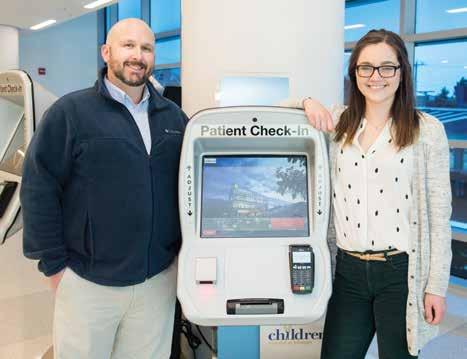
It also aimed her into a new career path, one she wasn’t considering before the project. “I really was unsure about the medical field. I was like, ‘Wait, a hospital? I’m in the College of Engineering. How does that really connect?’ But just seeing the connection between what I’m doing in school and healthcare and helping people was a big change. I now want to do this in my future.
“Our job is not to say we can do this with less people. It is to reutilize people and make it more efficient.” C
Bookshelf features new books written or edited by or about alumni and other members of the UTC community. To be included, send publisher’s press release and a high-resolution book cover image to magazine@utc.edu.
UTC ’17
J. KASPER KRAMER
The Story That Cannot Be Told
Atheneum Books for Young Readers

October 2019
J. Kasper Kramer ’17 is an author and English professor in Chattanooga whose first book, The Story That Cannot Be Told, was released in October. Kramer has a master’s degree in creative writing from UTC.
In the novel, Kramer tells the story of Ileana, a girl in Romania living in the final months of the Communist regime in 1989 Romania. Her Uncle Andrei, after publishing a story that criticizes Romania’s government, goes missing.
Fearing for her safety, Ileana’s parents send her to live with the grandparents she’s never met. But danger is still around.
Publishers Weekly gave The Story
That Cannot Be Told a starred review and called it “Mesmerizing.” Kirkus Reviews said: “Kramer's debut novel is rich with connections to today's world while easily sidestepping the pitfall of heavy-handedness.”
W utc.edu/bookshelf
Fall 2019 | 35
BOOKSHELF
Poet Jones, left, and Anna Tenpenny help design checkin kiosks for the Children's Hospital at Erlanger.
His 100th Career Win
Following the UTC women’s soccer win over Wofford Sept. 27, the Mocs’ sideline erupted in jubilation when it was announced that Head Coach Gavin McKinney had just recorded his 100th career victory. “Proud moment,” McKinney said. “When I think about both programs that I’ve taken over as head coach, (I remember that) both were at the bottom of their league standings. It’s not easy to win games. Lucky for me I’ve had a lot of good players over the years.”
McKinney took over a struggling UTC program after five successful seasons at Cumberland University where he amassed 71 wins. Last year, he led Chattanooga to its best record since 2005, finishing a goal shy of third place in Southern Conference standings. In five seasons, he has 31 wins with the Mocs with 16 of those wins coming the last two years. This season, UTC is 7-3-3 overall (with seven shutouts) and 2-1 in the SoCon. The Mocs began this fall with a four-game unbeaten streak and battled SEC foe Alabama to a draw. After holding No. 9 Vanderbilt to just three goals on the road, McKinney and his team marched past its next three opponents to get him to the century mark.

“I think it shows that when you have fantastic student-athletes who want to work and fight for each other and find ways to win games, you’ll have success,” McKinney reflected. McKinney also noted that the team’s move to the new UTC Sports Complex near Erlanger Hospital has been good. They are 3-1-2 in six contests there, including the 1-1 tie with Alabama.
Men's Golf
The men’s golf team is three tournaments into the 2019-20 season. Early on there was promising play, but team results were not there. However, upon heading west to California for match play, the Mocs found their mojo. They turned in their lowest 18-, 36- and 54-hole totals of the early season at the Alister Mackenzie Invitational.
The latter two were eye-popping when looking at UTC program record books. The 838 final tally is the fourth-lowest in school history. The group’s 551 two-thirds of the way through is the second-lowest score through 36 holes. Will Porter recorded a new career-low with 206, tying for the eighth-best 54-hole score in school annals.
Connor Nolan, who tied for 17th in Birmingham play, earning Southern Conference Golfer of the Week honors, was one of four Mocs to record rounds in the 60s on the West Coast, joined by Matt Smith, Oliver Simonsen and Nolan. The last time UTC did that well in a same event was April 2009 at the Administaff Augusta State Invitational.
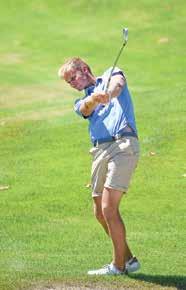
Three different student-athletes have led the Mocs in their three starts. A.J. Lintunen tied for 25th in the season-opening Carpet Capital, which was exceptionally strong considering the field included powerhouse Virginia.
Women's Golf
The women’s golf team got off to a strong start in autumn play led by the efforts of golfers one through three in the Mocs lineup. Sophomore Esme Hamilton has taken a major step forward. She registered her personal best 18-, 36- and 54-hole totals in each of the first three events, each time improving on her past lowest scores.
That culminated in a special performance at the Princess Anne Invitational in early October when Hamilton broke the school mark for a single card with 65, one better than Christine Wolf’s 66 during her win at the JMU Eagle Landing Invitational in 2011. Ironically, alumna Wolf won her first Ladies European Tour title, the Hero Indian Open, the same weekend as Hamilton’s scoring spree in Virginia. Hamilton earned her first Top 5, finishing third with a 5-under 205. It matched the school’s 54-hole record. Hamilton’s third-place finish earned her a sweep of the Southern Conference Golfer and Student-Athlete of the Week honors.
Maddy McDanel opened 2019 with a tie for 11th at Tennessee’s Mercedes-Benz
Collegiate, turning in an even-par 213 for the three rounds. Hamilton paced the effort later in the week, tying for 14th at Vanderbilt’s Mason Rudolph Championships. That duo, along with sophomore Rheagan Hall, are posting the best numbers of their careers. Hamilton leads the way at 71.44 strokes per 18, while McDanel’s 72.44 is second. Hall is third on the list at 73.56.
Left, former Moc Christine Wolf (2008-11) has played on the Ladies European Tour since 2014 and recently scored her first win at the 2019 Hero Women’s Indian Open in Gurgaon, India, on Oct. 3-6. A two-time All-SoCon performer during her collegiate career, she has also played in the Women’s U.S. Open (2011), the Women’s British Open (2017, 2018, 2019) and the 2016 Olympics.
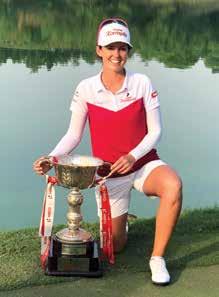
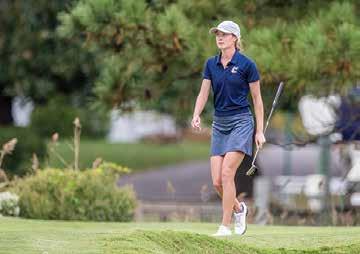
36 | The University of Tennessee at Chattanooga Magazine ATHLETICS
WILL PORTER
GAVIN MCKINNEY
ESME HAMILTON
Football Mocs Leading the Southern Conference at Mid-Season


The University of Tennessee at Chattanooga football team started the 2019 season with a 3-3 record and, at press time, stood 2-0 in Southern Conference action following a 34-17 win at Mercer. The Mocs made it through a non-conference schedule that was ranked second-toughest in the FCS and included games against Eastern Illinois, at No. 17 Jacksonville State, at Tennessee and No. 2 James Madison.

Running back Aliym Ford (Florence, S.C.) has emerged as one of the top freshmen in the country. Through
Freshman Ailym Ford has twice been named Honorable Mention National Freshman of the Week. He currently leads all freshmen in the FCS with 88.2 rushing yards per game.
six games, he led the Mocs with 92.8 rushing yards per game and five rushing touchdowns. Those numbers also led all freshmen running backs in the FCS. He has posted three 100-yard rushing games and was an Honorable Mention National Freshman of the Week after each of those outings.
Head coach Rusty Wright has the Mocs competing hard in his first year guiding the program. The 1996 UTC graduate took over for Tom Arth in December 2018 and has built a league title contender in just one season. Three of Chattanooga’s final six games are at home at Finley Stadium. UTC hosted ETSU, No. 11 Furman (Nov. 2) and The Citadel (Nov. 16). Tickets are on now at GoMocs.com or by calling the UTC Ticket Office at 423-266-MOCS (6627).
Former UTC football student-athlete and NFL Hall of Famer Terrell Owens (1992-95) was inducted into the San Francisco 49ers Hall of Fame on Sept. 22, 2019. Owens is also pictured with UTC Vice Chancellor & Director of Athletics Mark Wharton and Senior Associate Athletics Director Andrew Horton ’02.

Fall 2019 | 37
Junior Bryce Nunnelly, above, is the leading receiver at 355 yards and three touchdowns as of Oct. 5.
PHOTO BY FRANK MATTIA
PHOTO BY TENNESSEE TITANS
Left, former Moc Isaiah Mack ’15-’18 is a rookie with the Tennessee Titans. The defensive lineman has played in six games as of Oct. 14 and has 1.5 sacks.
Volleyball Team at Mid-Season
Following early invitational events at Mississippi State, Troy and Virginia Tech, as well as the Chattanooga Classic in September, the UTC Mocs women’s volleyball record was 5-11 and 0-3 in the Southern Conference under Coach Travis Filar. Thirteen SoCon matches remained on the schedule at press time, leading up to the year-ending Southern Conference tournament in Spartanburg, S.C. prior to Thanksgiving.
Fall Tennis Format
Senior Dani Szczepanski has led the way, surpassing 800 career kills and 100 career aces, becoming just the ninth Moc in program history to hit 100 aces. She currently ranks fourth all-time at UTC with a career .303% attack percentage. Junior Megan Kaufman has recorded over 1,100 career digs in under three seasons at UTC, climbing the career charts to 11th all-time. She ranks fourth all-time at UTC in the total digs (1,134) post-rally scoring era, which took effect across NCAA competition following the 2008 season.
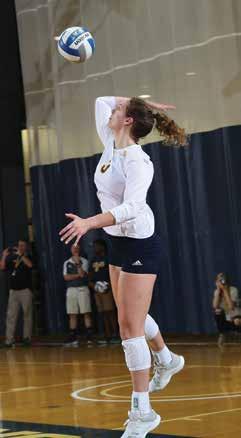
The Mocs men’s and women’s tennis teams are in the middle of their fall individual competition. Spring is the championship season for NCAA tennis, but teams use the fall to hone their individual skills against outside competition. All fall play must be in a tournament format, and no dual meets are allowed until the spring season begins.
Senior Niklas Gerdes advanced to the qualifying round at the 2019 Saint Francis Health System/ITA Men's All-American Championships in Tulsa, Okla., in early October, where he won four matches at the prestigious national event. The men also hosted the second annual Chattanooga Collegiate Clay Court Championships at Manker Patten in September, while the UTC Steve Baras Fall Classis was to wrap up at press time at the UTC Tennis Center.
The women have five events on their fall slate. The ITA Ohio Valley Regionals is the marquee tournament, and was to be hosted by MTSU Oct. 20. They close out fall competition at the Louisville Invitational on Nov. 1-3.
In October, women’s tennis freshman Jessie Young won the 2019 University of Cincinnati/Pam Whitehead Invitational. She scored 18 points in singles action to take the top spot in the tournament.
The Mocs also held an Alumni Match Sept. 21 (see photo). The well-attended event featured former players returning to campus from all over the country. Former Mocs tennis players are encouraged to keep an eye on GoMocs.com for the date of next year’s match.


The current UTC Men's Tennis team, below, joined alumni in the Alumni Match on Saturday, Sept. 21, at the UTC Tennis Center.
Of note, the netters hosted a “Green Out” match to promote awareness for mental health and bone marrow donation in October as part of the Southern Conference’s #SoConnected social media campaign.
38 | The University of Tennessee at Chattanooga Magazine ATHLETICS
JESSIE YOUNG
DANI SZCZEPANSKI
Cross Country Roundup: Men
The Mocs were nearing the end of the 2019 regular season with one October meet and the Southern Conference Championships in November. A mixture of youth and experience has led the cross country runners.
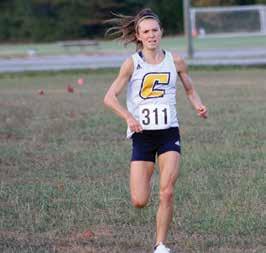

Sophomore Jonathan Boyd’s successful freshman campaign has carried over into this season as with personal best times in three meets. Senior Nathan Watson has provided steady leadership, and Jake Etheridge returned to the course after sitting out last season with an injury.
The men placed third at the Tennessee Tri-Star meet and and won the UTC Twilight meet. The Louisville Classic is always a challenge for the Mocs, who ran alongside many of the nation’s top teams in that event. However, they came away with personal best times for four of six participants.
Women
Senior Makenzie Jones along with freshman Lesley Green have provided a strong pair of long-distance runners for the Mocs, with several other members of the cross country squad trading in-and-out in the next three spots. Jones led the Mocs to a title at the UTC Twilight meet, and she was 27th at the prestigious Louisville Classic where she went up against some of the top runners in the nation. Green also was the Mocs top finisher at the Tennessee Tri-Star meet.
Added Roles
Chris Smith, director of the University of Tennessee at Chattanooga School of Nursing, is adding a new set of responsibilities to her already-healthy schedule. She was recently named the university’s Chief Health Affairs Officer, a position overseeing the Counseling Center, University Health Services, the Center for Student Wellbeing and the Healthy Living Initiative/Healthy Mocs.
“This position is the perfect marriage of what I have done for many years as a family nurse practitioner at University Health Services and my role as an educator for the school,” she says. “We teach our students about health promotion and wellness every day, so this new responsibility is a natural extension of what I do every day.”
As Chief Health Affairs Officer, directors and others from the various centers and initiatives will report to Smith. She says she will meet with them weekly “to support them as they carry out the programs associated with their missions.” Smith reports to Yancy Freeman, vice chancellor for Enrollment Management and Student Affairs, who says she was “the optimal choice.”
“Dr. Smith’s tenure leading UTC’s School of Nursing and the tremendous credibility she has gained within the regional healthcare community made her the optimal choice,” he says. “The breadth and depth of her experience should provide a holistic approach to health and wellness for our student population.”
At the School of Nursing, Smith managed the three-year lead-up to a visit from the Commission on Collegiate Nursing Education accreditation, a visit that occurs every 10 years. “Our initial report states we had no findings or concerns. The CCNE board will have a final review vote in May 2020 to grant us the full 10-year accreditation,” Smith reports. C

Student Well-Being: Scrappy’s Cupboard
Scrappy’s Cupboard provides emergency food assistance to all UTC students. It is coordinated by the Office of the Dean of Students and run by faculty, staff and student volunteers. The cupboard offers non-perishable food items, kitchenware, blankets, sheets and personal-care items which include deodorant, toilet paper and laundry detergent.
It opened its doors in 2017 and helps ease some students’ anxieties about having enough food. The cupboard is currently near the Office of the Dean of Students but in a private location so students can access it discreetly. Stop by or call the Dean of Students office to make an appointment at 423425-2299 or schedule a visit online at utc.edu/scrappyscupboard
Scrappy’s Cupboard is open to UTC students currently enrolled with at least one credit hour and in need of emergency food assistance. There are no requirements for students’ first visits to Scrappy's Cupboard and no limit on how many times they can come by.
When the Dean of Students office is closed, emergency food bags are available in residence halls and the Administrative Services building on campus at 400 Palmetto St.
Scrappy’s Cupboard welcomes donations throughout the year, including food items or money. To help, call the Dean of Students at 423-425-4761. C
Fall 2019 | 39 NOTEWORTHY
MAKENZIE JONES
NATHAN WATSON
Hannah Caldwell, Sophia Neglia and Ashlynd Broling have alternated in the lineup, providing necessary depth to the squad. The women close out the season at the Berry College Invitational and continue training for the upcoming SoCon Championships in Johnson City, Tenn., set for Nov. 2.
Jim Exum ’03 has joined the Chambliss Bahner & Stophel law firm as a member of the litigation and risk management practice groups with an emphasis on government and municipal litigation and domestic law. Photo 9

Jeffrey
Crystal
Robin Derryberry ’82, ’85 been named chair of the Tennessee Human Rights Commission for a two-year term. She was first appointed to the panel in 2015 by former Tennessee House Speaker Beth Harwell. Derryberry and her husband, Andy Derryberry, are principals at Derryberry Public Relations. Photo 5



Michael Baskette ’75 is sales manager at PlainView LED digital sign company. He previously spent eight years as director of the fleet and commercial department at Mountain View Chevrolet. Photo 6

Gary Reese ’03 has joined Pinnacle Financial Partners as a senior vice president. Reese previously worked for SunTrust and AmSouth.



Roger Qualey ’83 has joined Pinnacle Financial Partners as a senior vice president. Prior to Pinnacle, he spent 17 years at both Atlantic Capital Bank (FSG Bank) and Pioneer Bank (AmSouth Bank). Photo 7

Debbie Ingram ’84 has been inducted into the Cleveland, Tenn. High School Hall of Fame. Photo 8
Vascular Institute of Chattanooga has added Marysol Thomas ’06 as a nurse practitioner. She is certified as a family nurse practitioner by the American Association of Nurse Practitioners. Photo 10

Matt Hisey

11
Please send your Alum Notes along with a photo to: magazine@utc.edu (Images must be 300 dpi, JPG format for publication)
IN MEMORIAM
Victor W. Bumphus passed away on May 31. A faculty member of the UTC Department of Social, Cultural and Justice Studies since 2002, he taught criminal justice, mentored undergraduate and graduate students as well as his junior colleagues in the department. He was nationally and internationally recognized for his research on policing, police accountability and ethics, and he examined issues such as race, bias and attitudes on drug control policy and sentencing. His work was published in journals such as the International Journal of Criminology and Sociology, Journal of Ethnicity in Criminal Justice, Criminal Justice Policy Review and American Journal of Criminal Justice. He was principal investigator working on strategies to enhance law enforcement response and service to victims of crimes as well as developing a Southeastern Command and Leadership Academy and evaluating a Tennessee Meth Task Force. He served as an evaluator for a UTC Violence against Women grant and most recently was chair of the UTC Police Hiring and Promotion Board.
Gregory M. Thibadoux passed away on Aug. 1. As a faculty member of the Department of Accounting at Gary W. Rollins College of Business, he spent more than 30 years teaching both graduate and undergraduate courses. Thibadoux received a bachelor’s degree in anthropology in 1968 from the University of Memphis, a master’s degree in audiology in 1972 from the University of Memphis and doctorate in accounting in 1984 from the University of Houston. During his career, he published more than 100 articles in a variety of academic journals. His personal commitment to teaching was evident in his dedication to his students and in the joy he derived from their professional achievements. A prolific reader, he was well-versed on subjects such as art, literature, anthropology, history, philosophy, theology and all things related to the human condition. His belief in the power of education to improve the lives of others was evidenced by his contributions to both organized charities and individuals. He was an active member of Calvary Baptist Church.

40 | The University of Tennessee at Chattanooga Magazine ALUM NOTES 4
U.S. Army Col. Patrick T. Birchfield ’95 has been appointed chief of medicine at Fort Campbell, Ky. Photo 1
Jackson ’86 has been appointed manager in the Procurement Source Selection Office at NASA’s George C. Marshall Space Flight Center, where he will be responsible for the center’s competitive source-selection activities. Photo 2
Privett ’01 is now director of service operations for member benefits administration at BlueCross BlueShield of Tennessee. Photo 3
Robert Vitolins ’18 was hired by financial life management firm Patton Albertson & Miller as a trading operations analyst. Photo 4
3 6 8
2 9 11 10 12 1 5 7
’10 has been named a partner in the accounting firm of Mauldin & Jenkins’ Chattanooga office. Photo
Professor Emeritus Roland Carter was recently honored as a Master of the Spiritual at the Lincoln Center in New York City. Photo 12
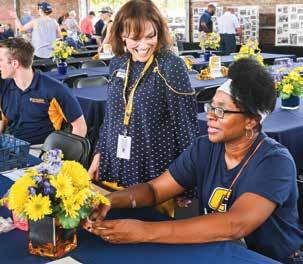


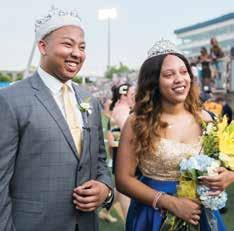

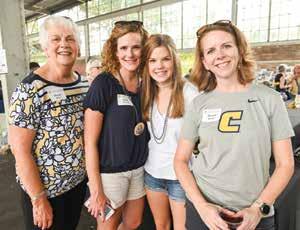


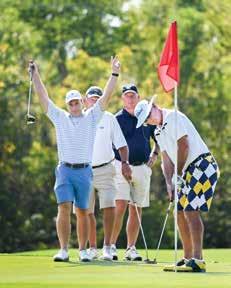


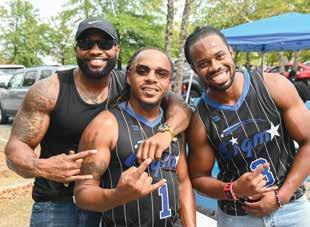
Fall 2019 | 41 HOMECOMING
ONE MORE STEP
By Shawn Ryan
A fter four tours of duty in combat
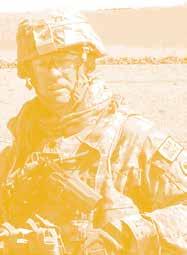
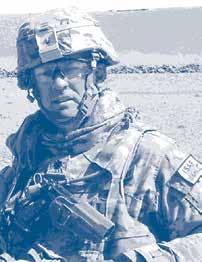

zones—two in Iraq, two in Afghanistan—Dane Snowden returned home for good. No more tours of duty loomed in front of him; he’d done his duty.
But he brought back something that still haunts him. PTSD. “A lot of the trauma, a lot of the PTSD is the monster under your bed. It doesn’t go away,” says Snowden, a senior electrician in the University’s Facilities Planning and Management Department. “I still remember the first guy I saw dead. I cut him down from a tree where he’d hung himself. Those things don’t go away.”
Snowden talks about his experiences, his feelings, his ups and downs without any hesitation. Having been in counseling for years—“Counseling is great!” he says sincerely—he knows there’s absolutely no shame in discussing his time in war zones. At 62, his eyes are the same light blue seen inside icebergs, and he looks you directly in the eye when he speaks about the lingering effects of his military service.
When he returned to the U.S., he had very few people to talk with about his experiences and what he was feeling. His Army buddies were scattered about the Southeast, but none were in Chattanooga. “There was no communication,” he says. “I was trying to deal with all this stuff and there’s no one who could really relate to you.”
Oh, there were plenty of people who wanted to talk to him, but none of those conversations were helpful. “They want to talk to you, but they want to know ‘cool’ stuff. Did you kill anybody? Did you shoot anybody? They didn’t want to know the stuff that makes you not sleep at night.”
He lost two good friends in Afghanistan. One was a helicopter pilot who crashed into the side of a mountain while returning to base. The other was a civilian member of Blackwater Security, a private company that provided security forces in war zones. “I was sitting at my desk, typing away when all of a sudden this huge blast,” Snowden recalls.
His friend’s vehicle—a Chevrolet Suburban with steel plating and bulletproof glass—had rolled over an improvised explosive device, or IED. “Those things go through tanks,” Snowden says. “It blew him and four guys completely up, melted the Suburban.”
He experienced multiple mortar barrages, IED explosions, the sound of gunfire. Even after years back in the States, he
still can’t stand loud, booming noises. If someone taps him on the shoulder from behind and he doesn’t know they’re there, he jumps. “I’m very claustrophobic still. I don’t like elevators. I have to take them because it’s part of my job, and I have to tell myself, ‘That’s a step in a positive direction. Get in that elevator and ride that elevator. You’re not going to die. You won’t die in the thing. It’s not your last breath on earth. Take a breath and go step by step.’”
“Take one more step” is a mantra from his counseling sessions, which he still attends once a month at the local Office of Veterans Affairs. “PTSD counseling is about one more step,” he says. “That step is not going to hurt you. It’s not going to kill you. You’re afraid to approach something. ‘Oh, I’m going to fail.’ Well, how are going to know if you’re going to fail if you don’t take that one step?
“If you take one step forward and you get turned down, it’s positive. You’ve faced it. It wasn’t what you wanted, but at least you took a step, and you encountered the thing you thought was going to be negative the whole time. But if you took that step the other way, you’d never know what the outcome was going to be.” C
42 | The University of Tennessee at Chattanooga Magazine NOTABILIS
Thanks to a 10-year-old partnership between the University and local non-profit Cornerstones, Inc., the iconic, 1906 Chattanooga Terminal Station has campus and community advocates for its preservation. Cornerstones established a Professor-in-Residence at UTC dedicated to historic preservation education and involves students of UTC’s Interior Architecture Department in identifying historic properties that need preservation. Cornerstones launched a capital campaign to save the terminal, made famous by the “Chattanooga Choo Choo,” and donations can be made online at: www.choochooterminal.fund


(423)

Office of Communications and Marketing Dept. 5655 615 McCallie Ave. Chattanooga, TN 37403 Nonprofit Org. U.S. Postage PAID Permit No. 26 Chattanooga, TN ART by Yasmina Reza November 20 – 24, 2019 Cadek Recital Hall, 725 Oak St. OUTLOOK A Student/Faculty Devised Program February 4 – 8, 2020 Locations and Times TBD PARADE by Alfred Uhry and Jason Robert Brown March 22 – 31, 2020 Mizpah Congregation, 923 McCallie Ave.
TKTS NOW ON SALE utc.edu/theatre
Photo
by Matthias Wagner on Unsplash













 By Shawn Ryan
By Shawn Ryan












 By Gina Stafford
By Gina Stafford
 By Shawn Ryan
By Shawn Ryan





 By Shawn Ryan
By Shawn Ryan













































